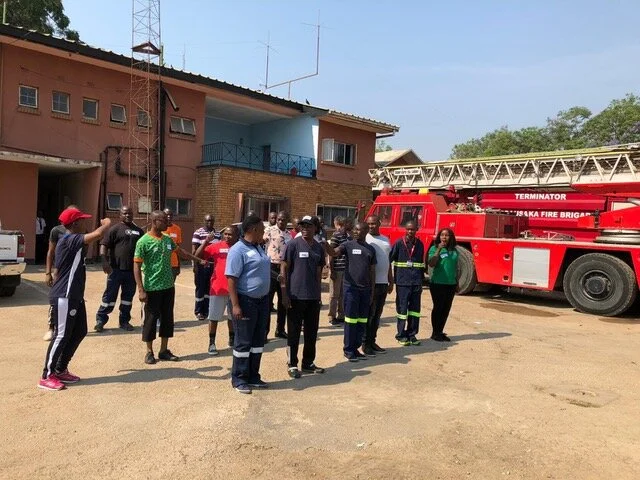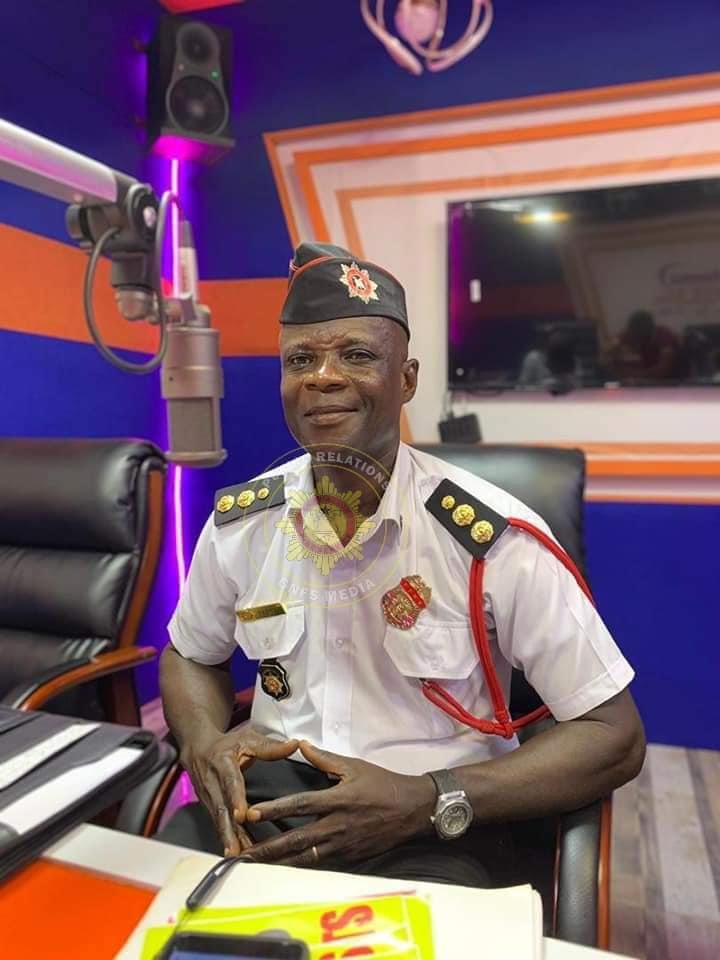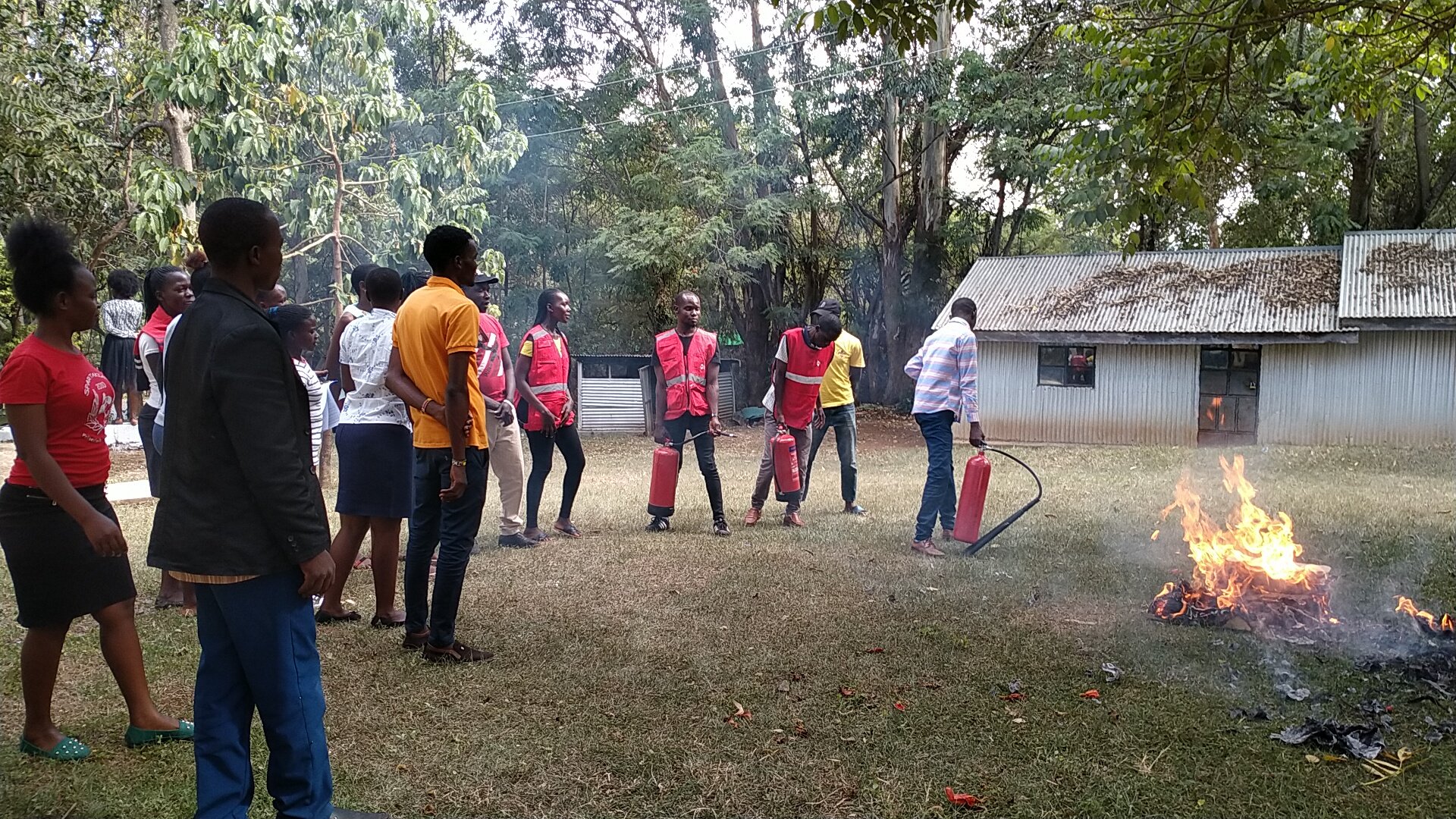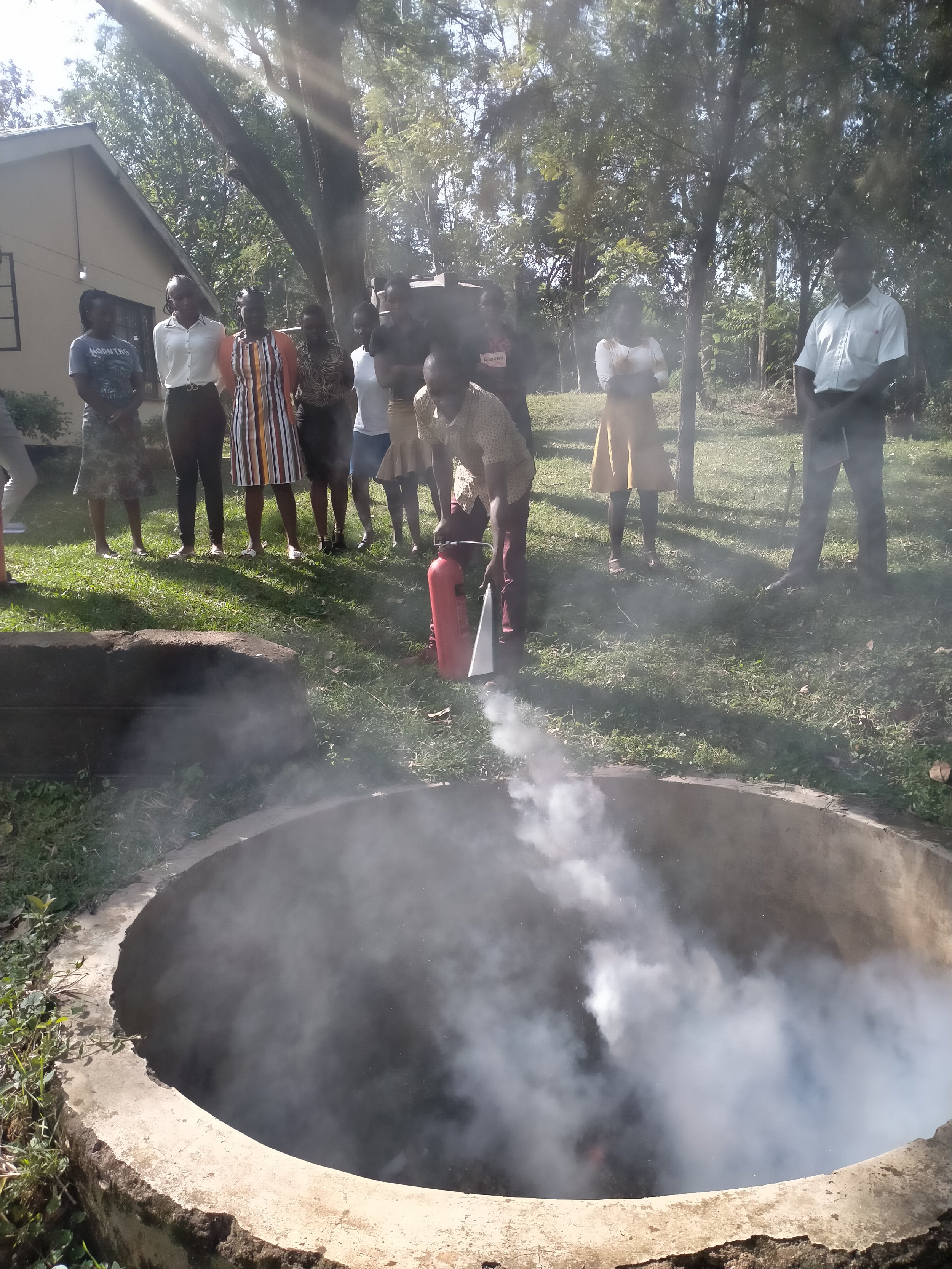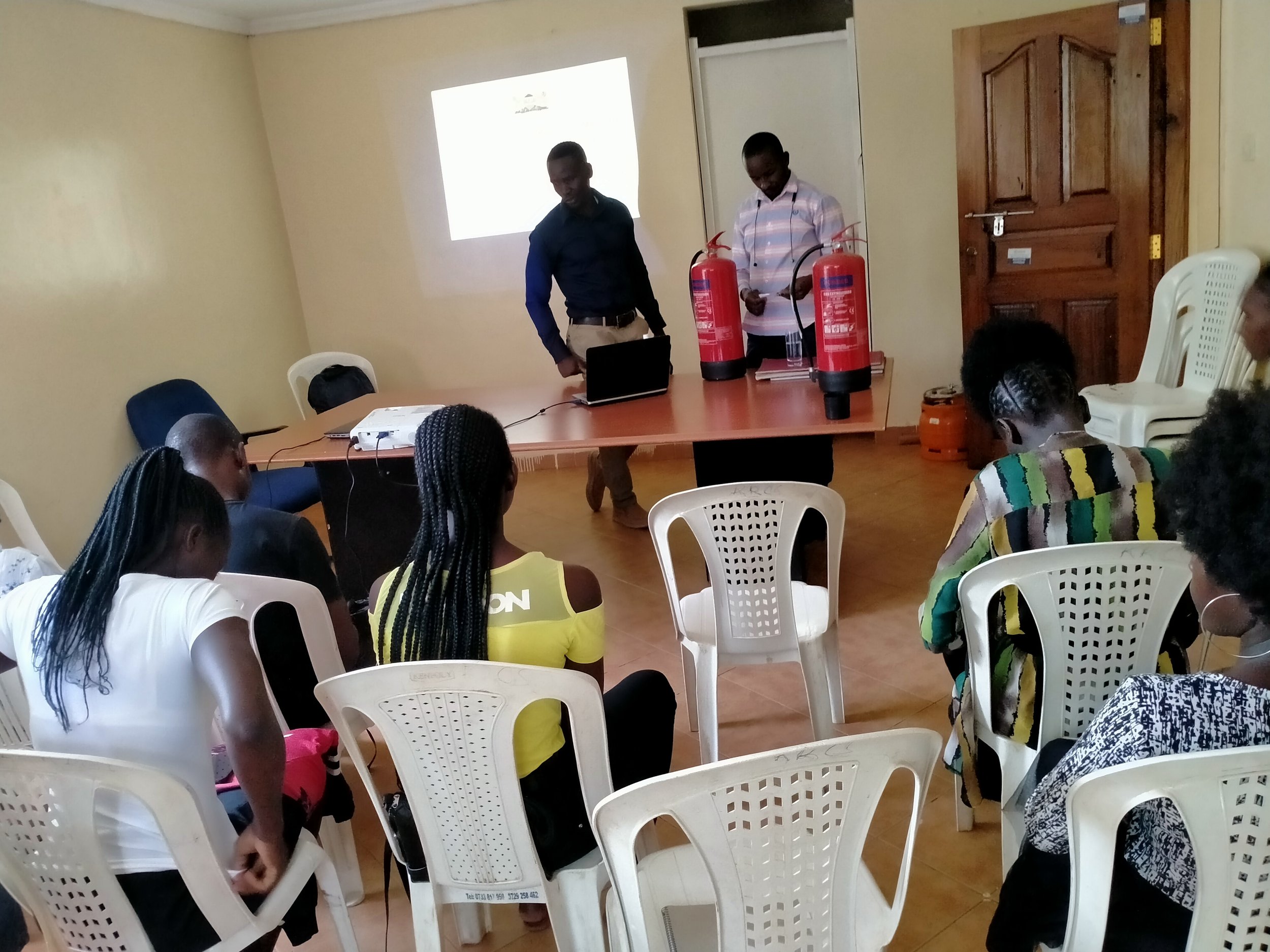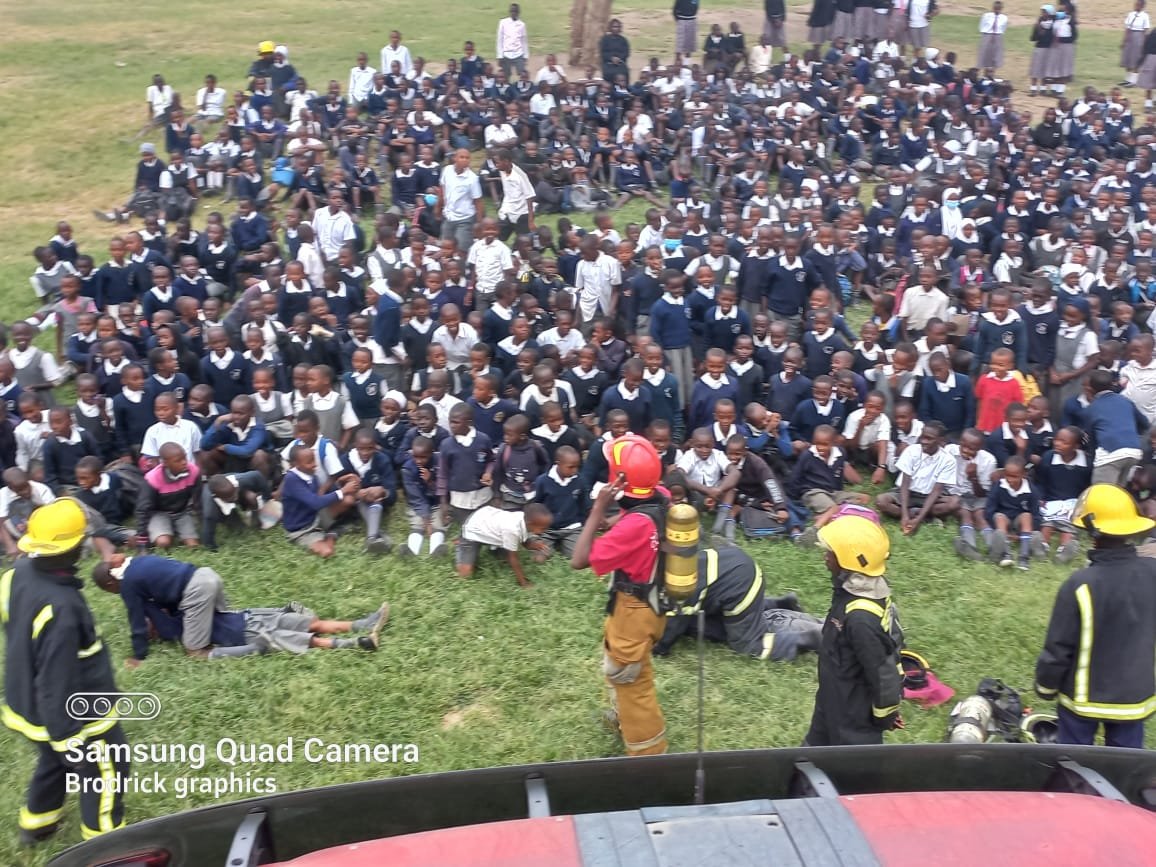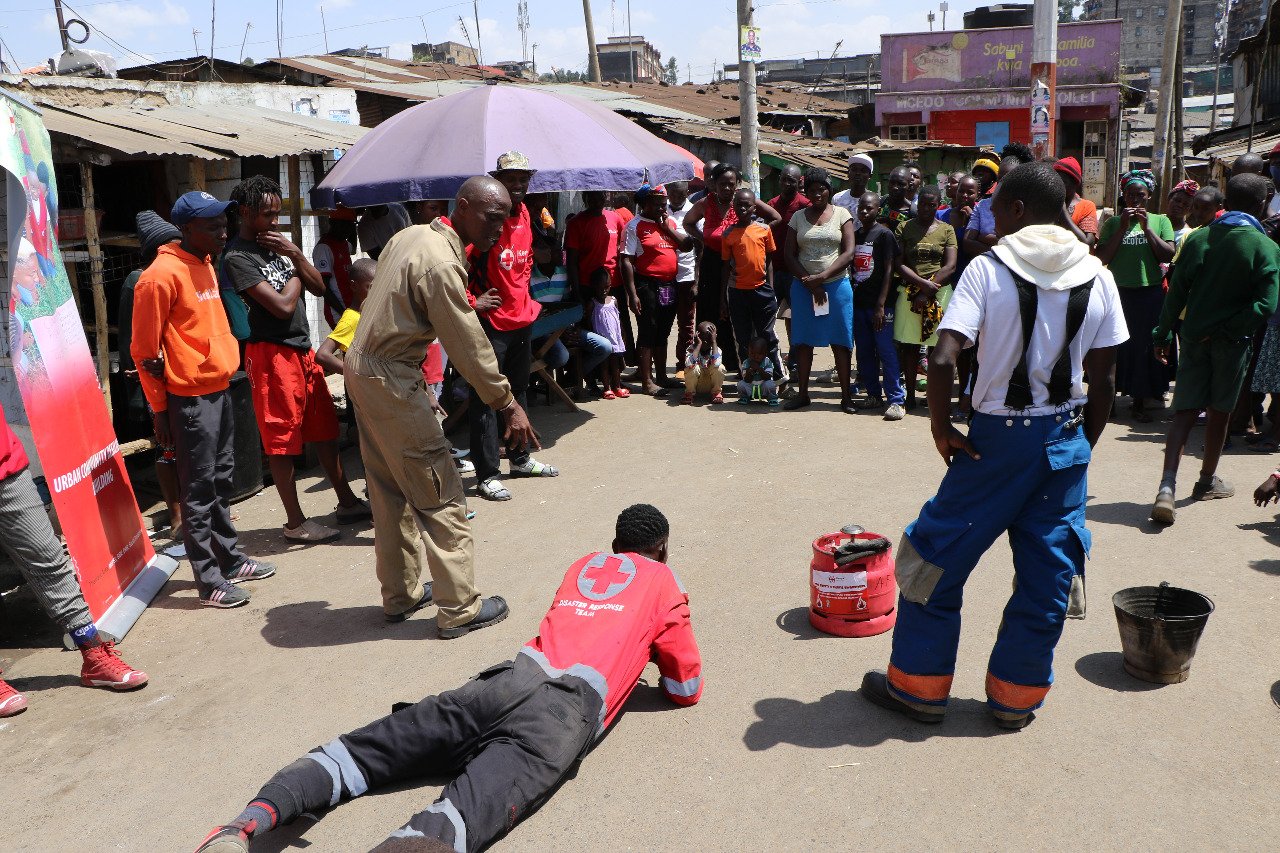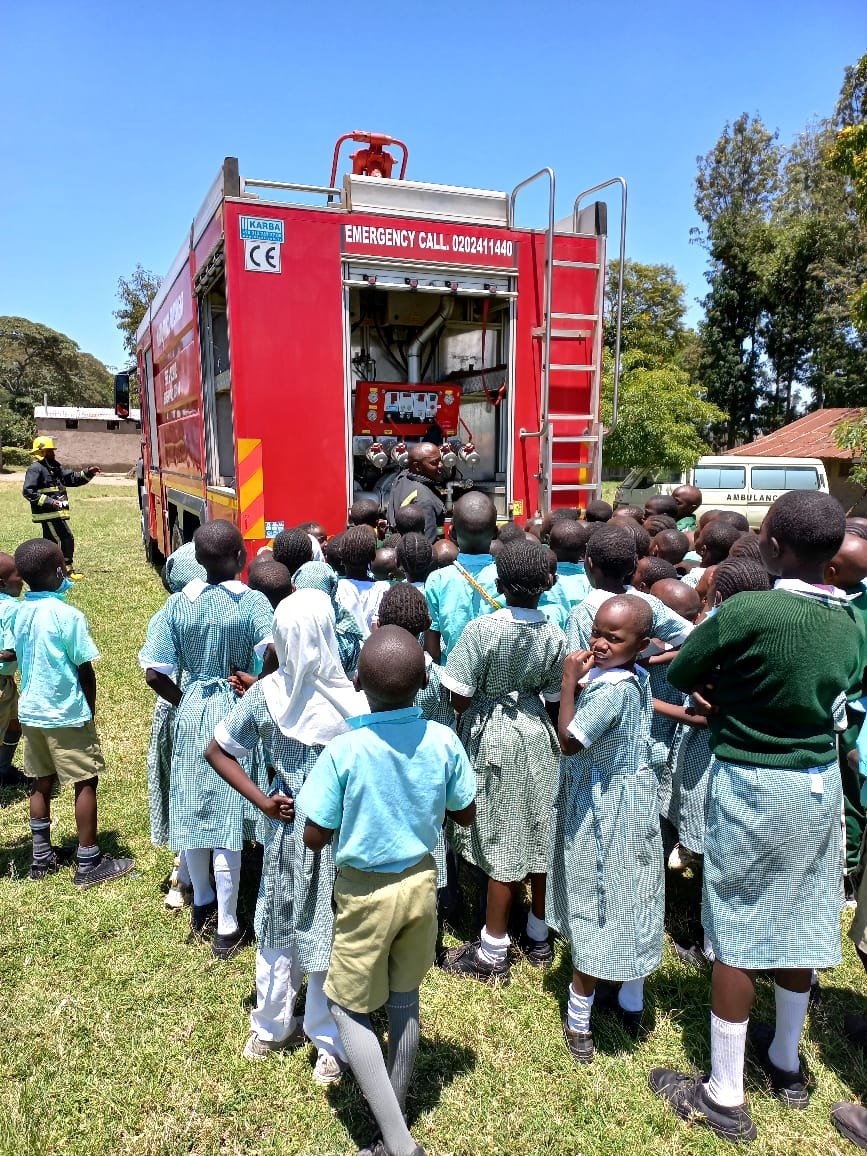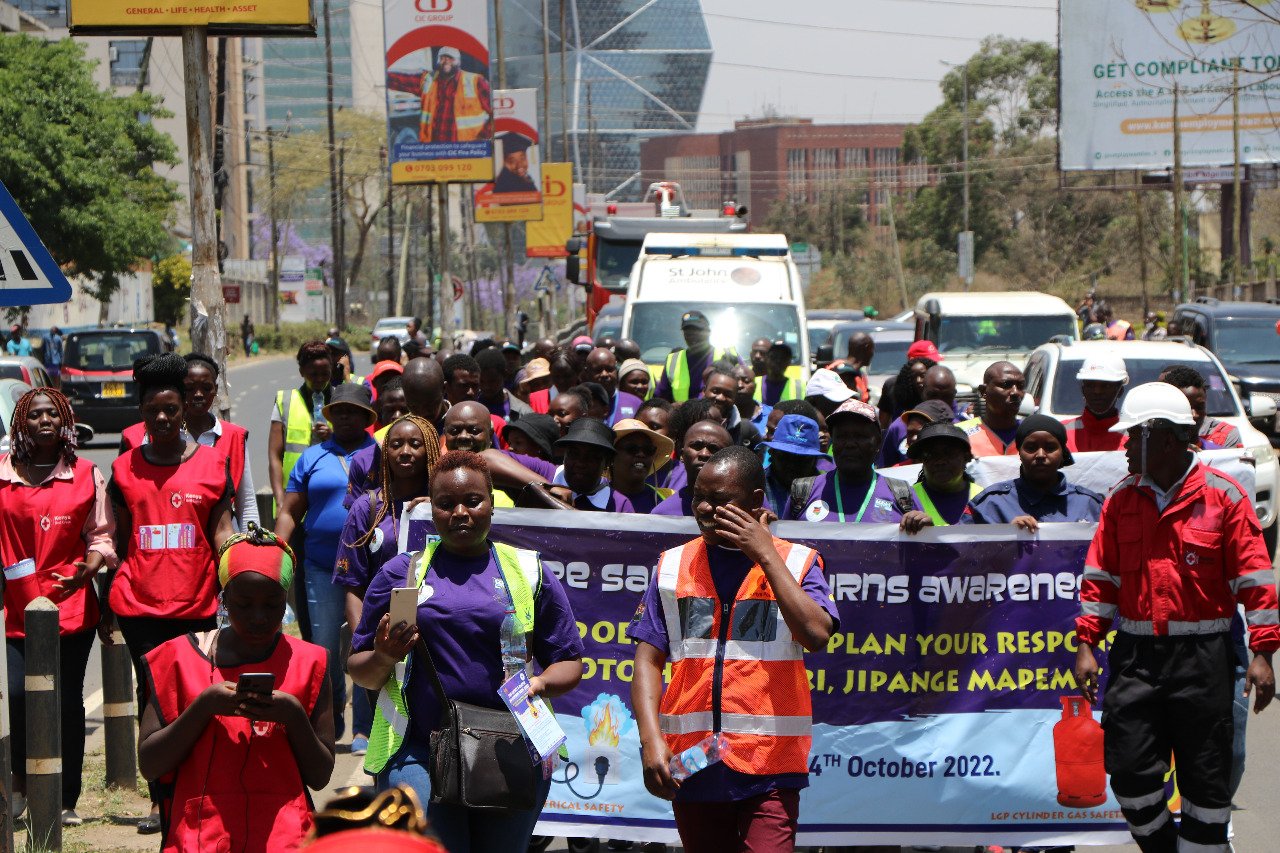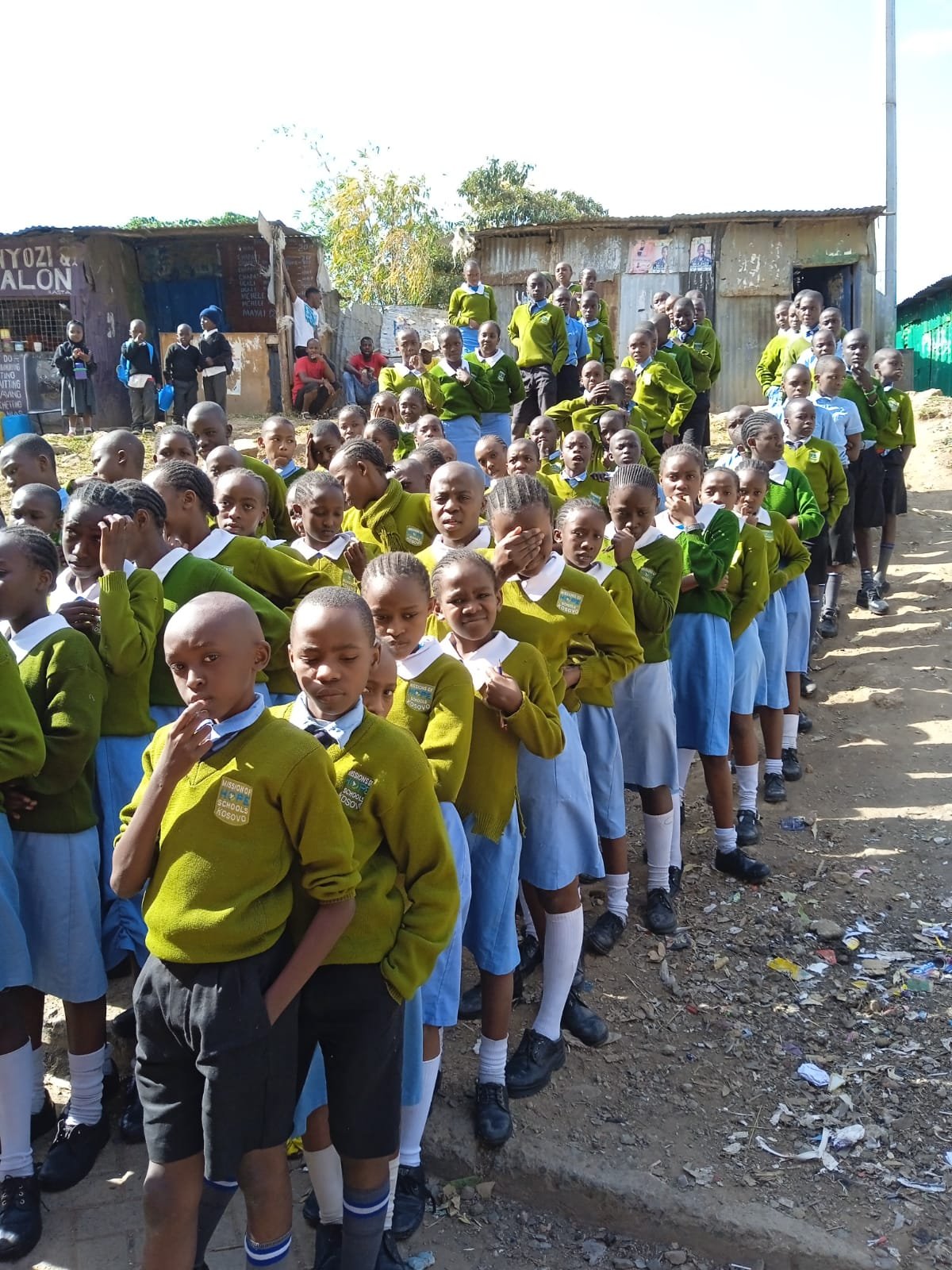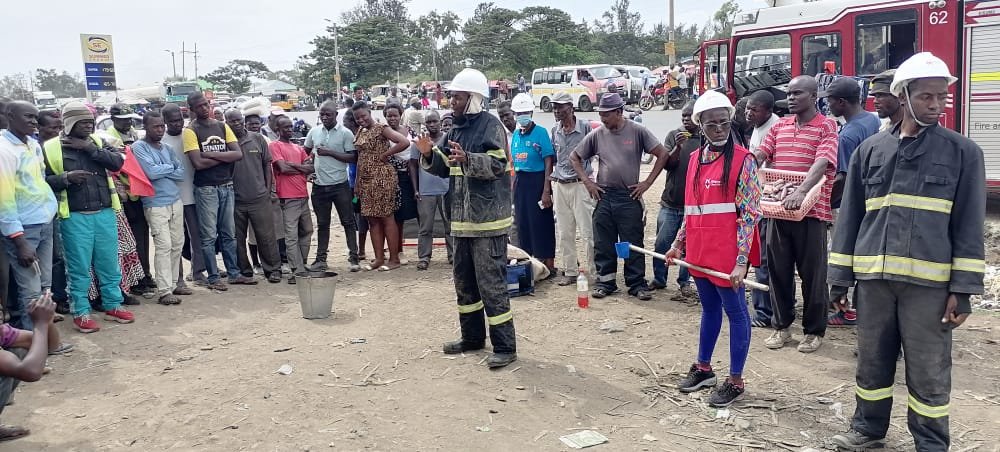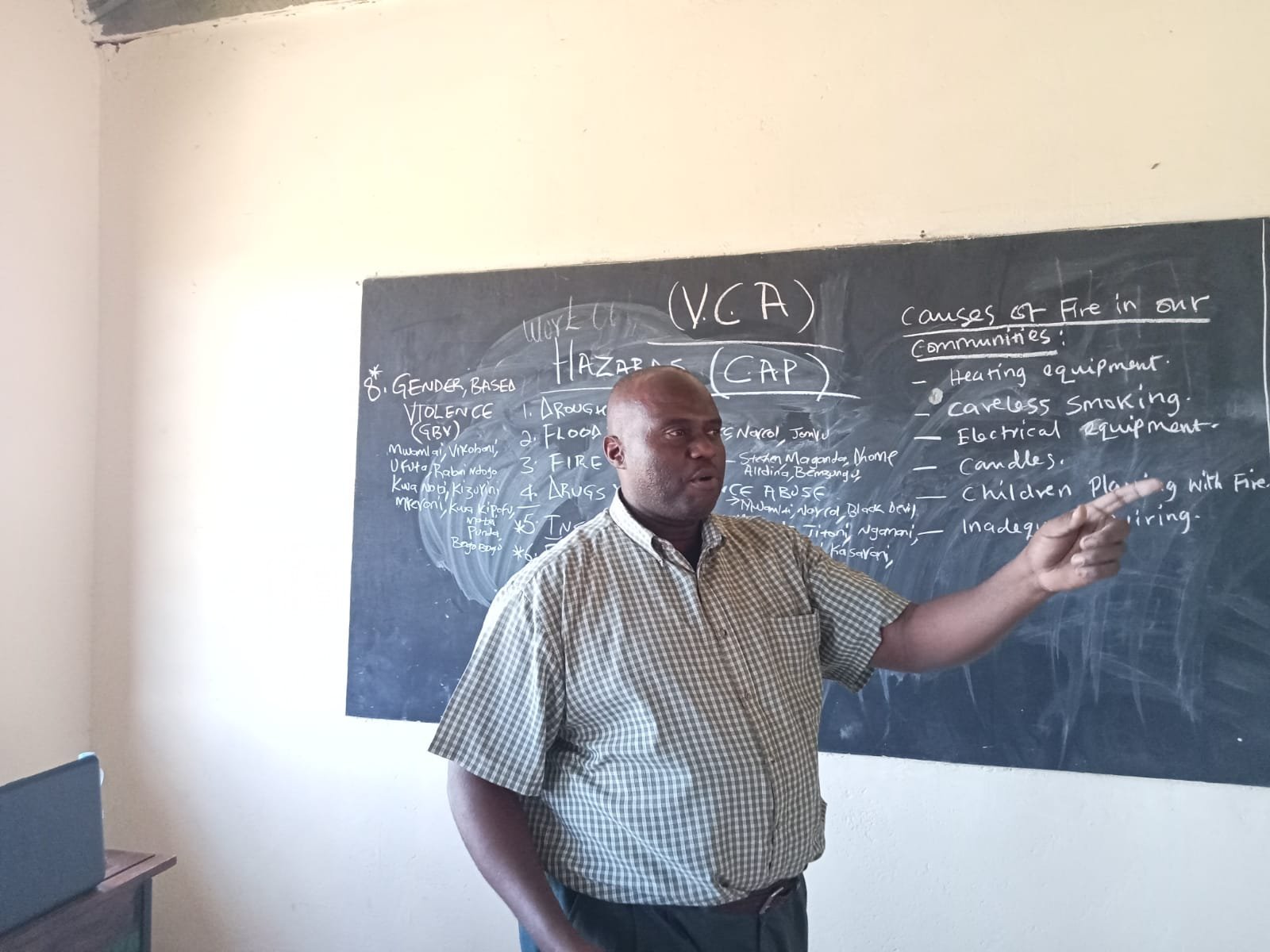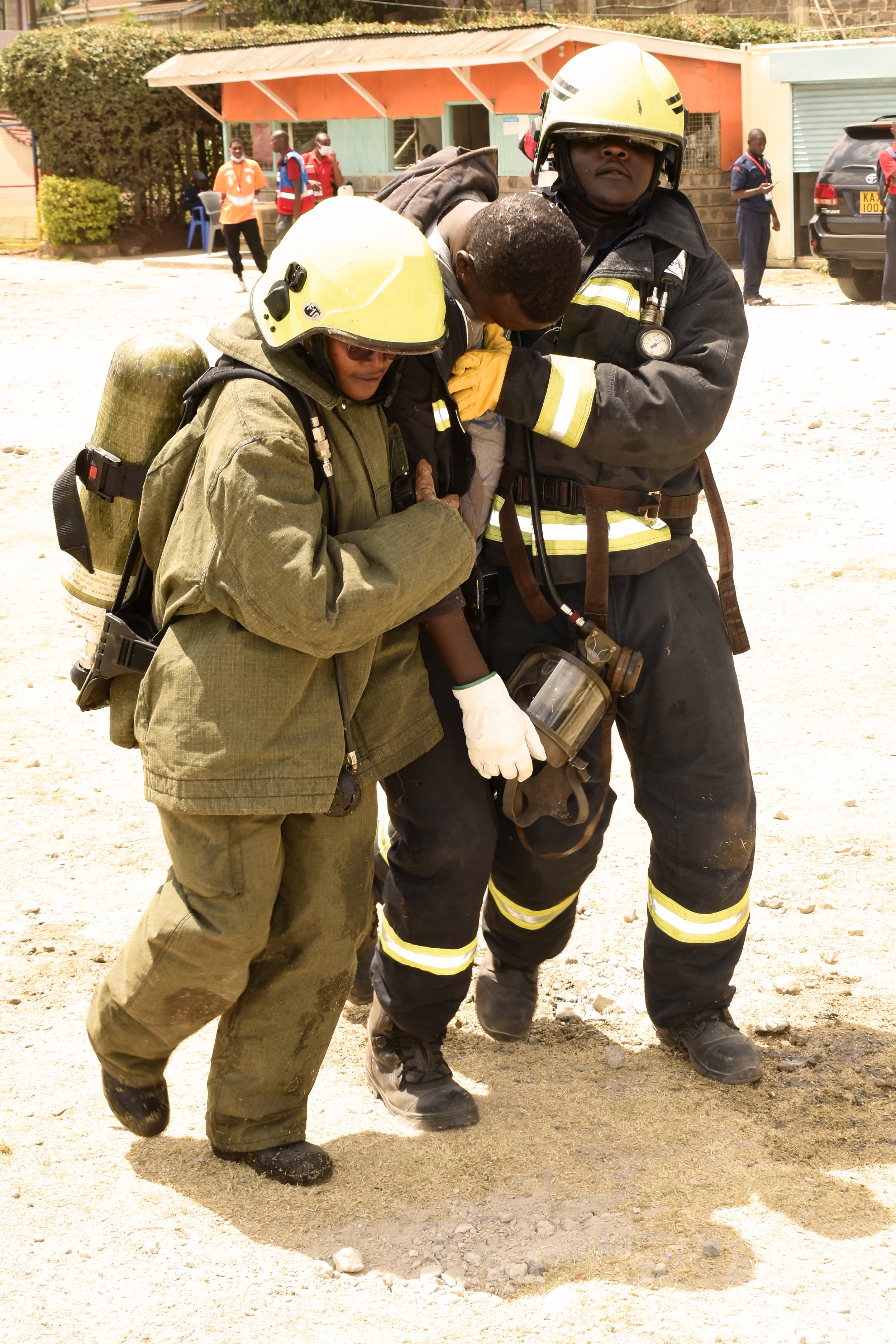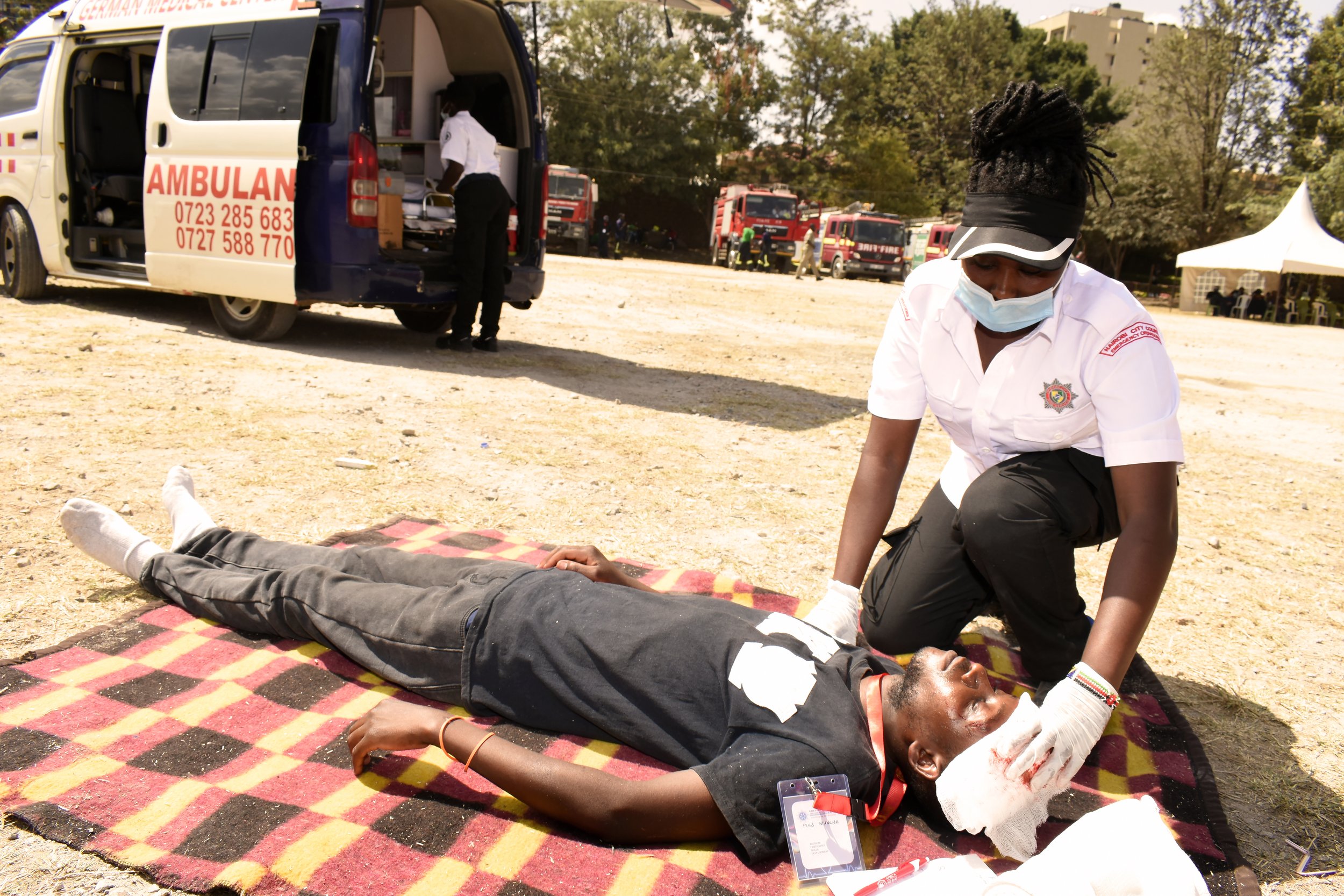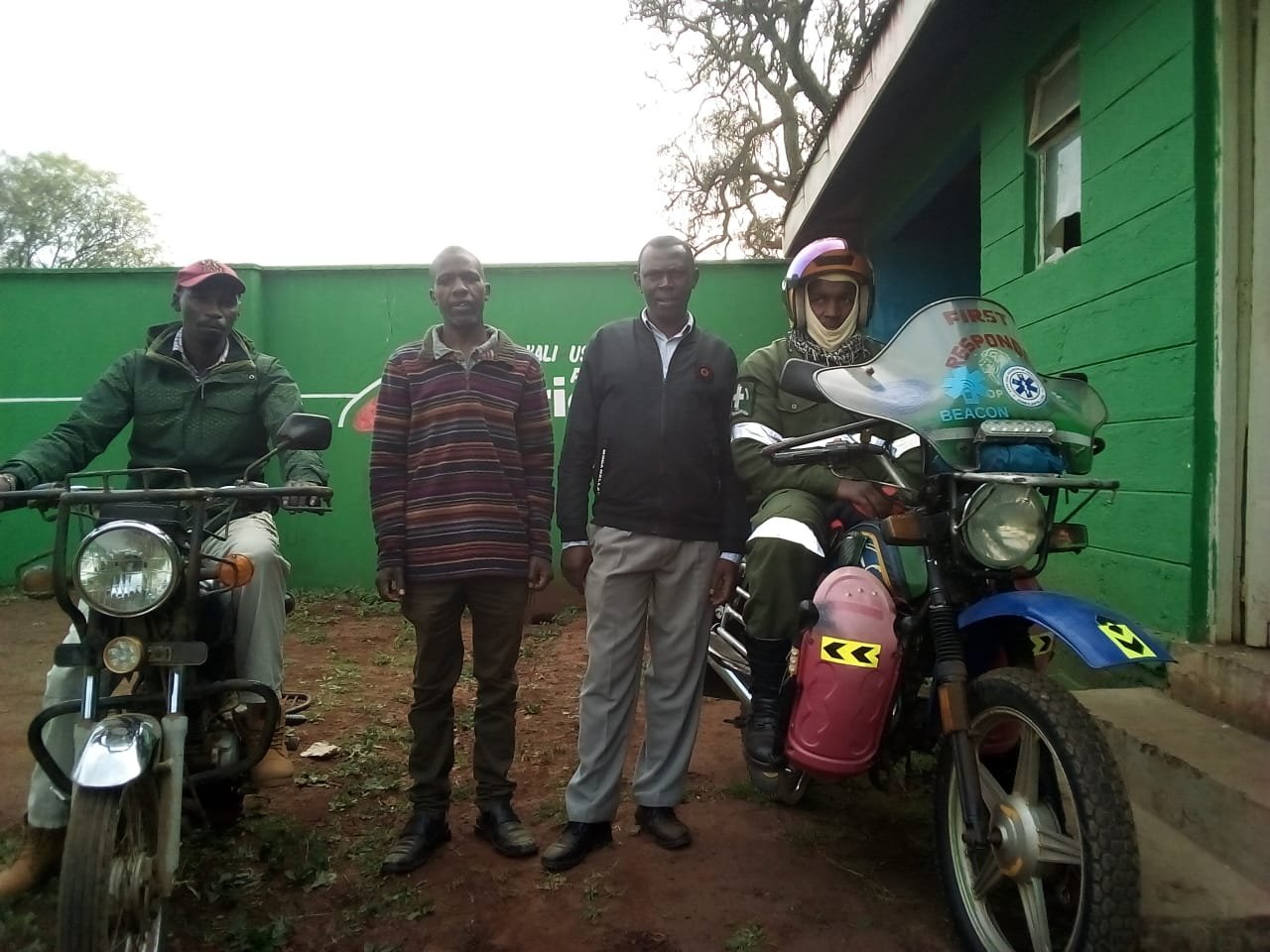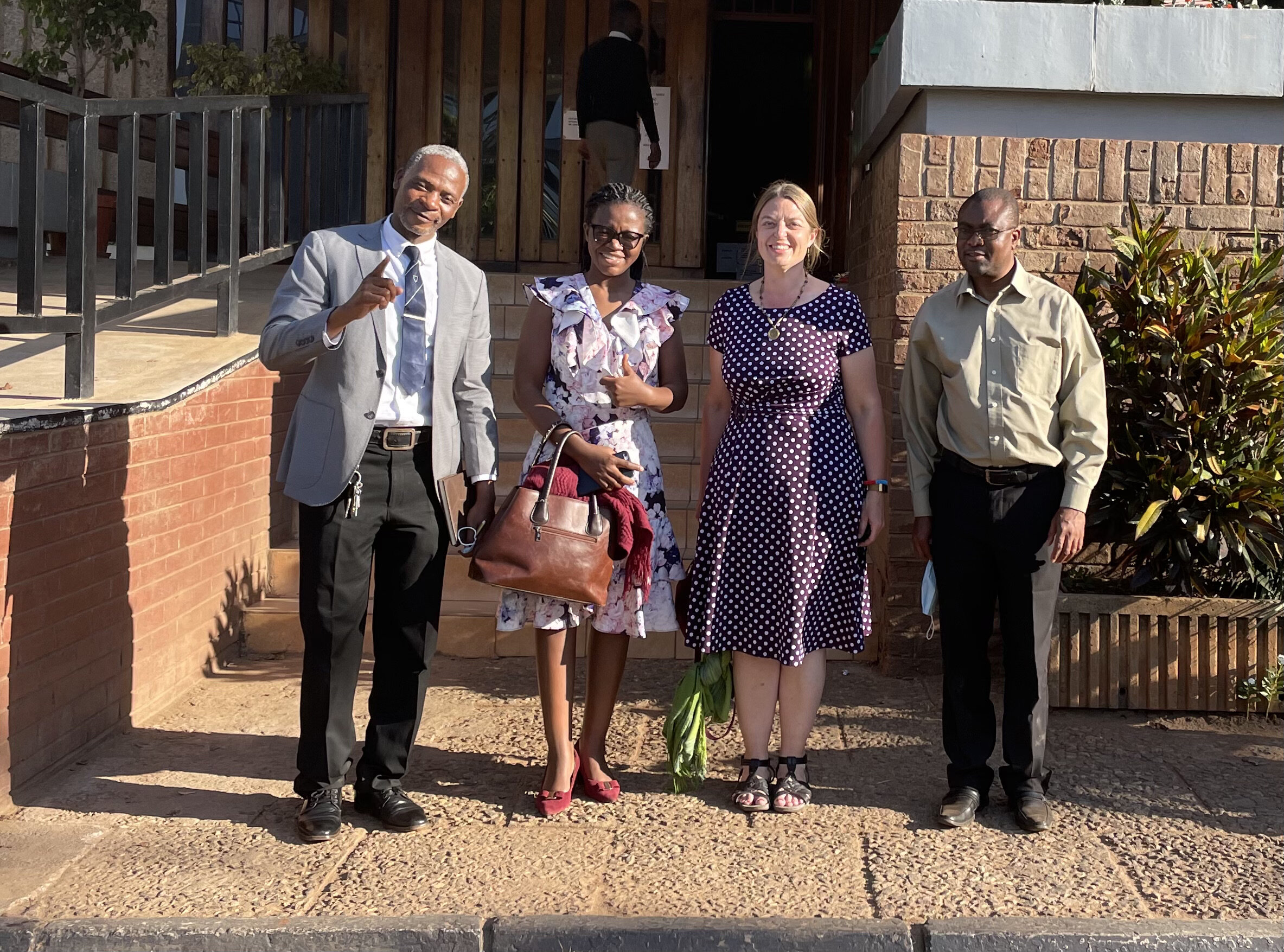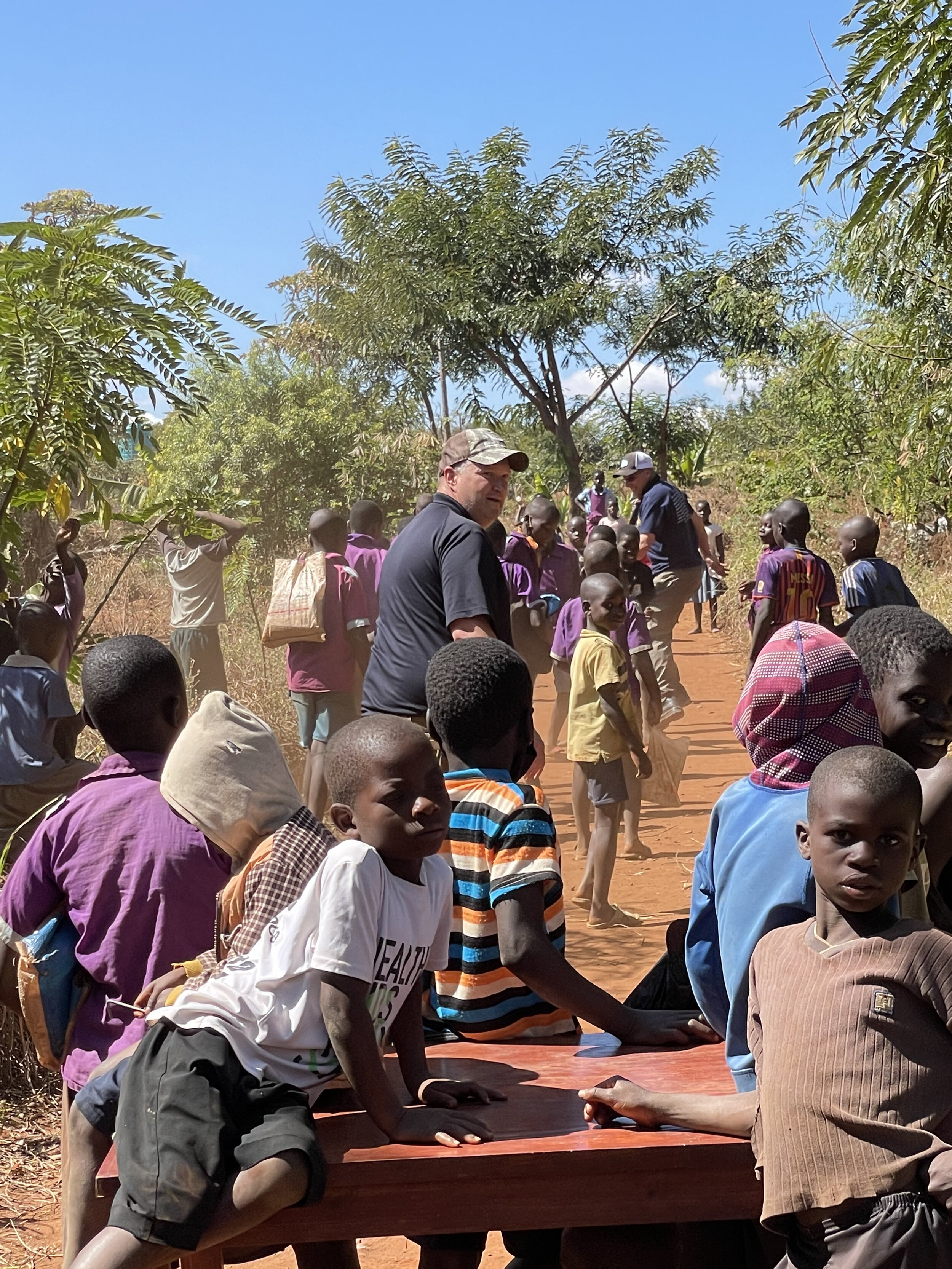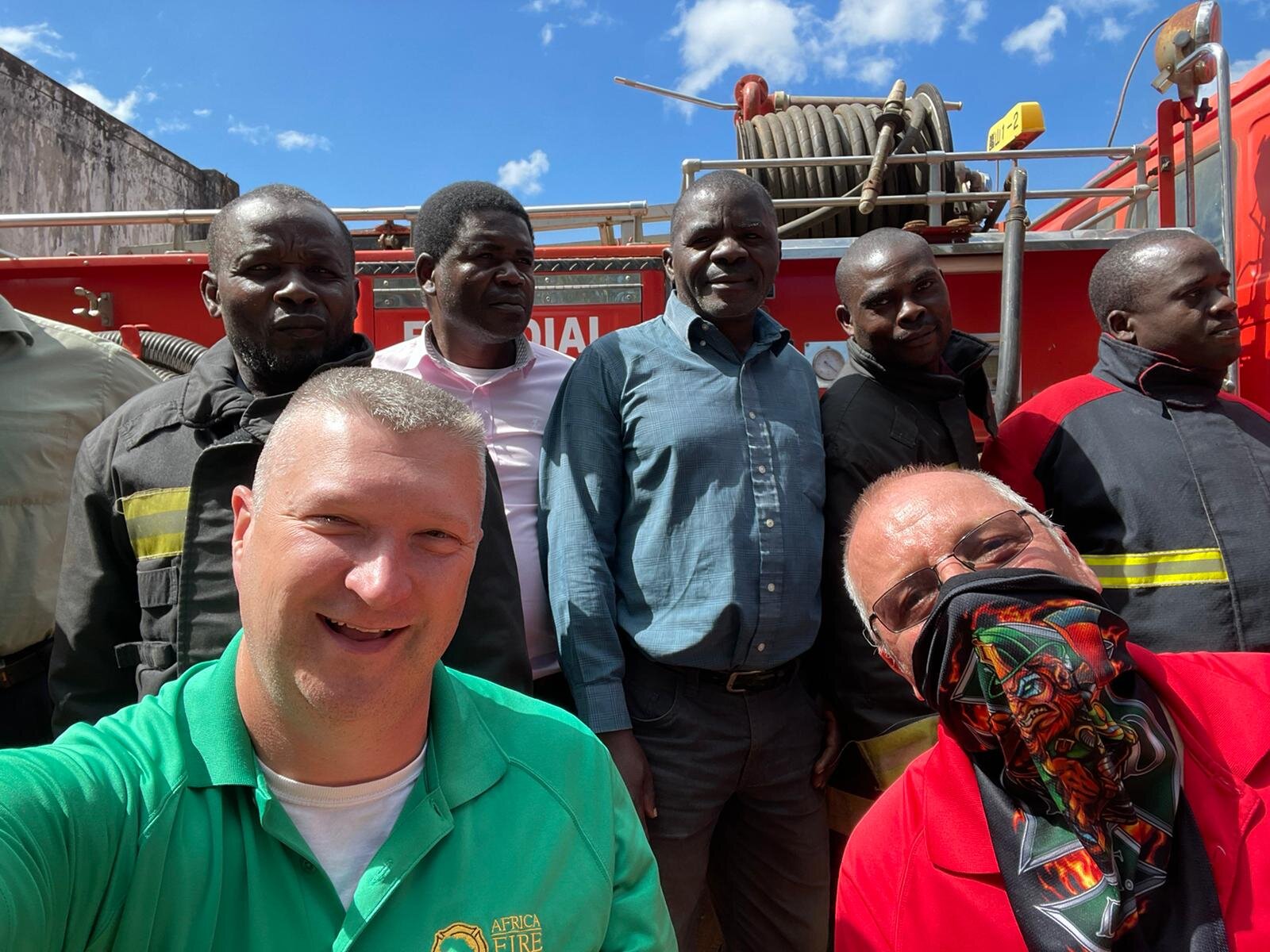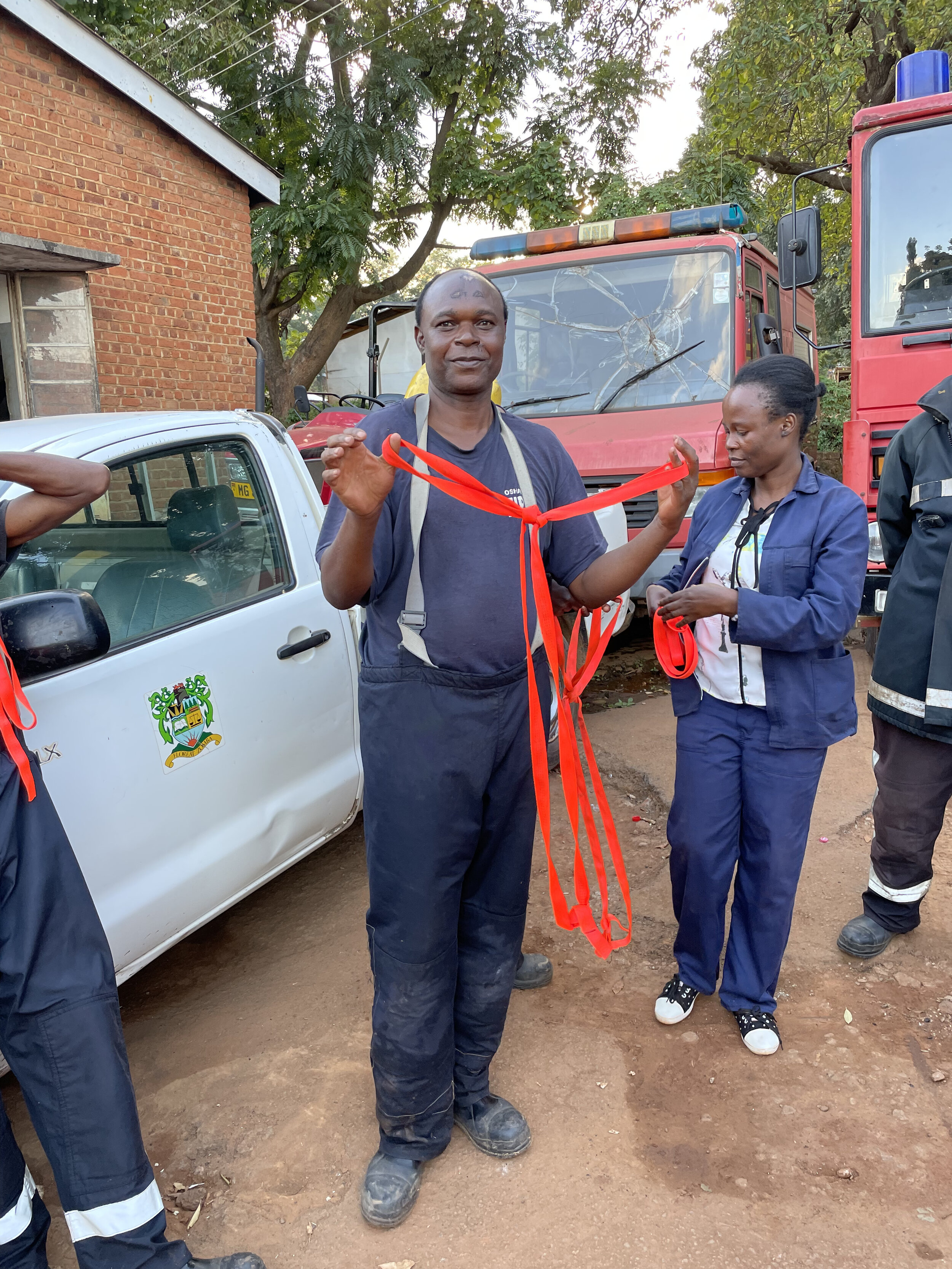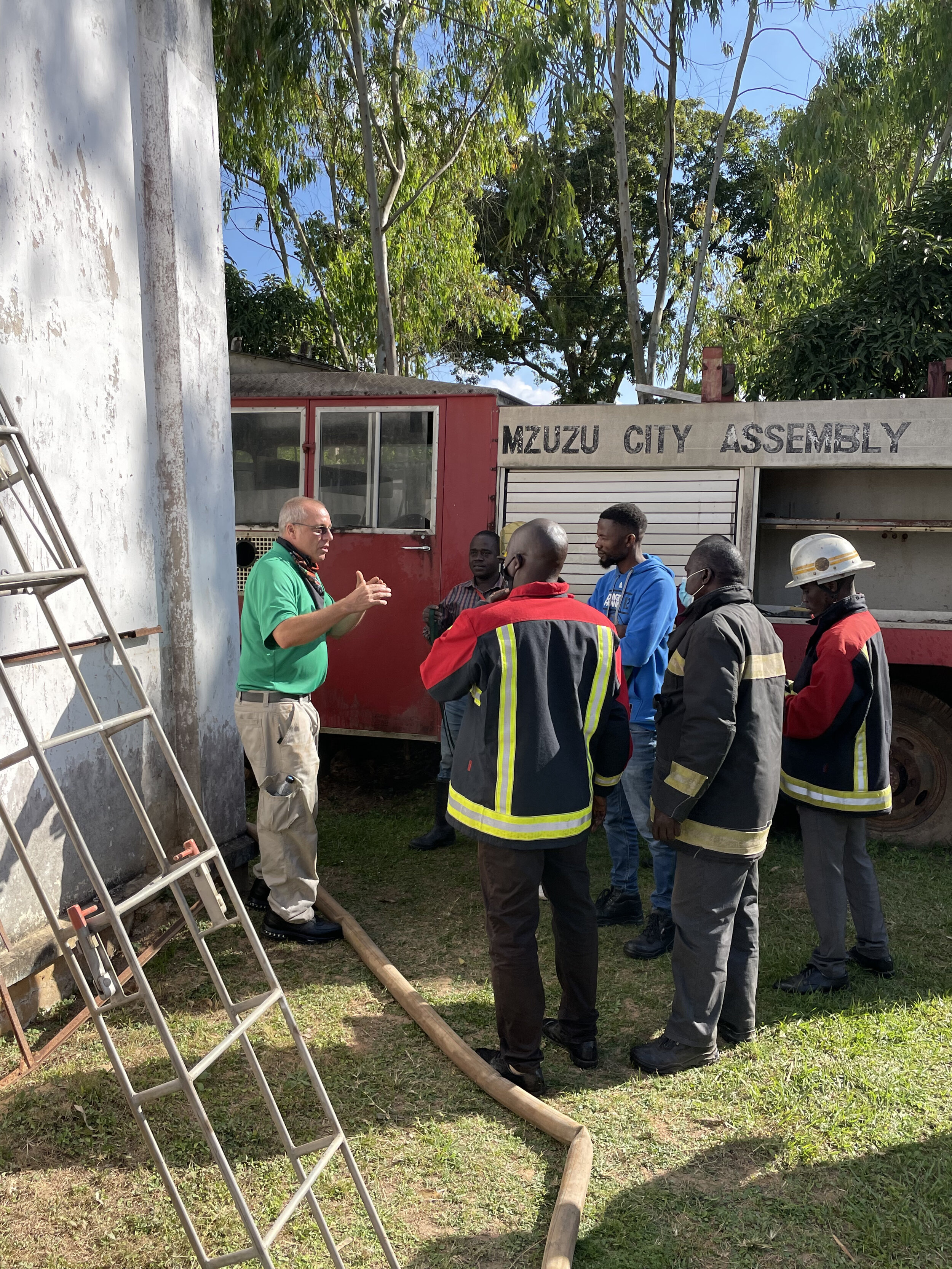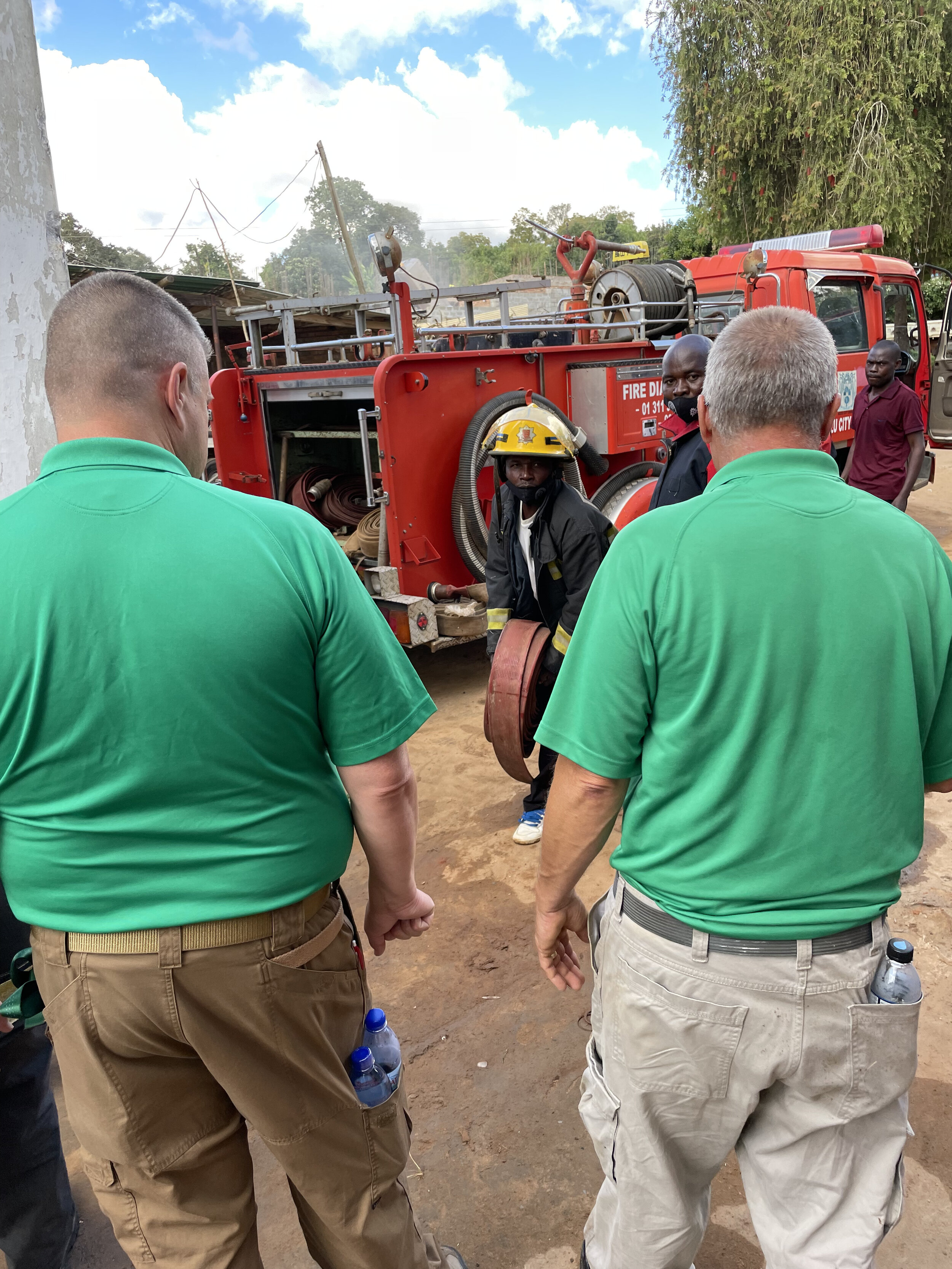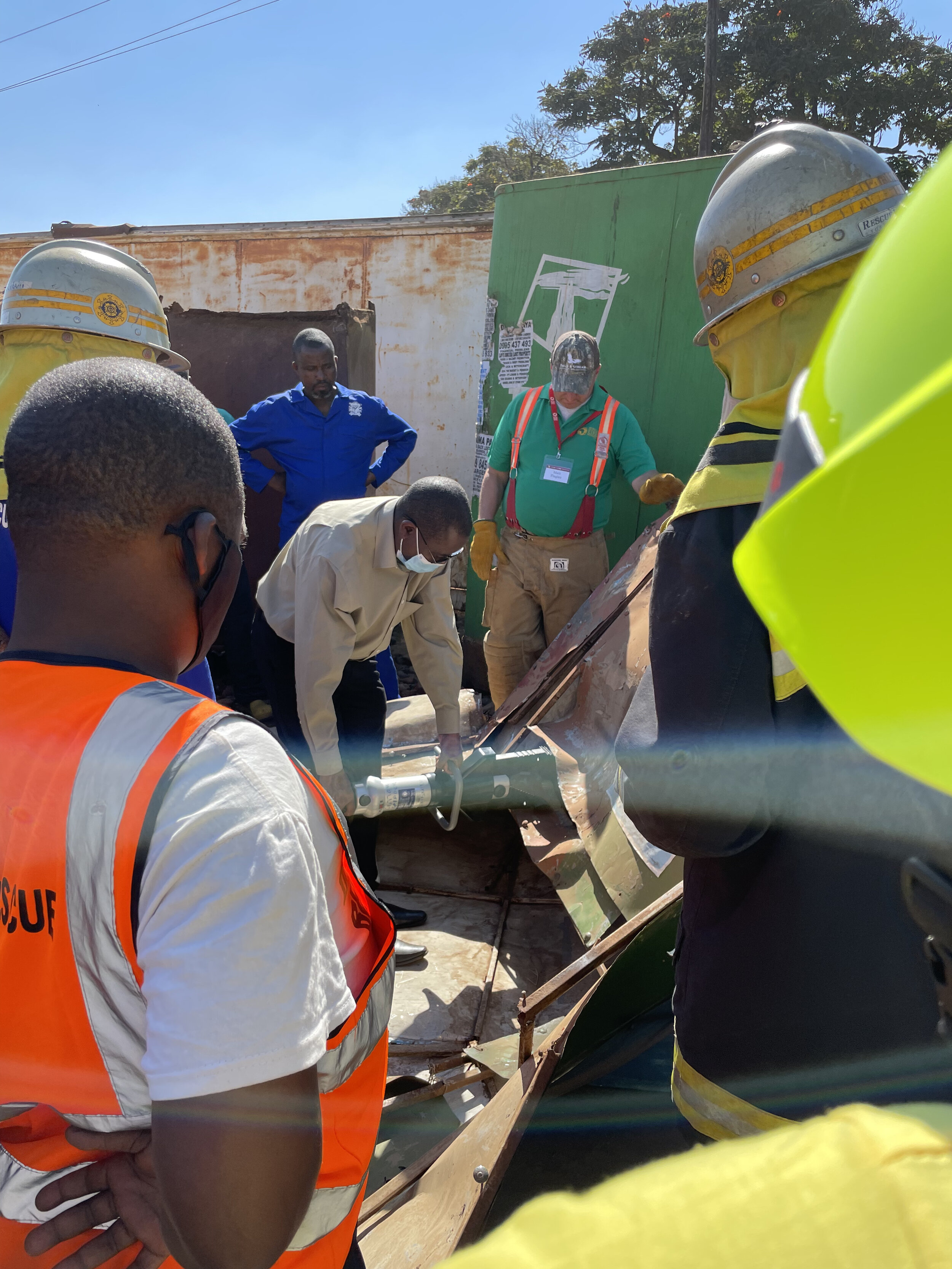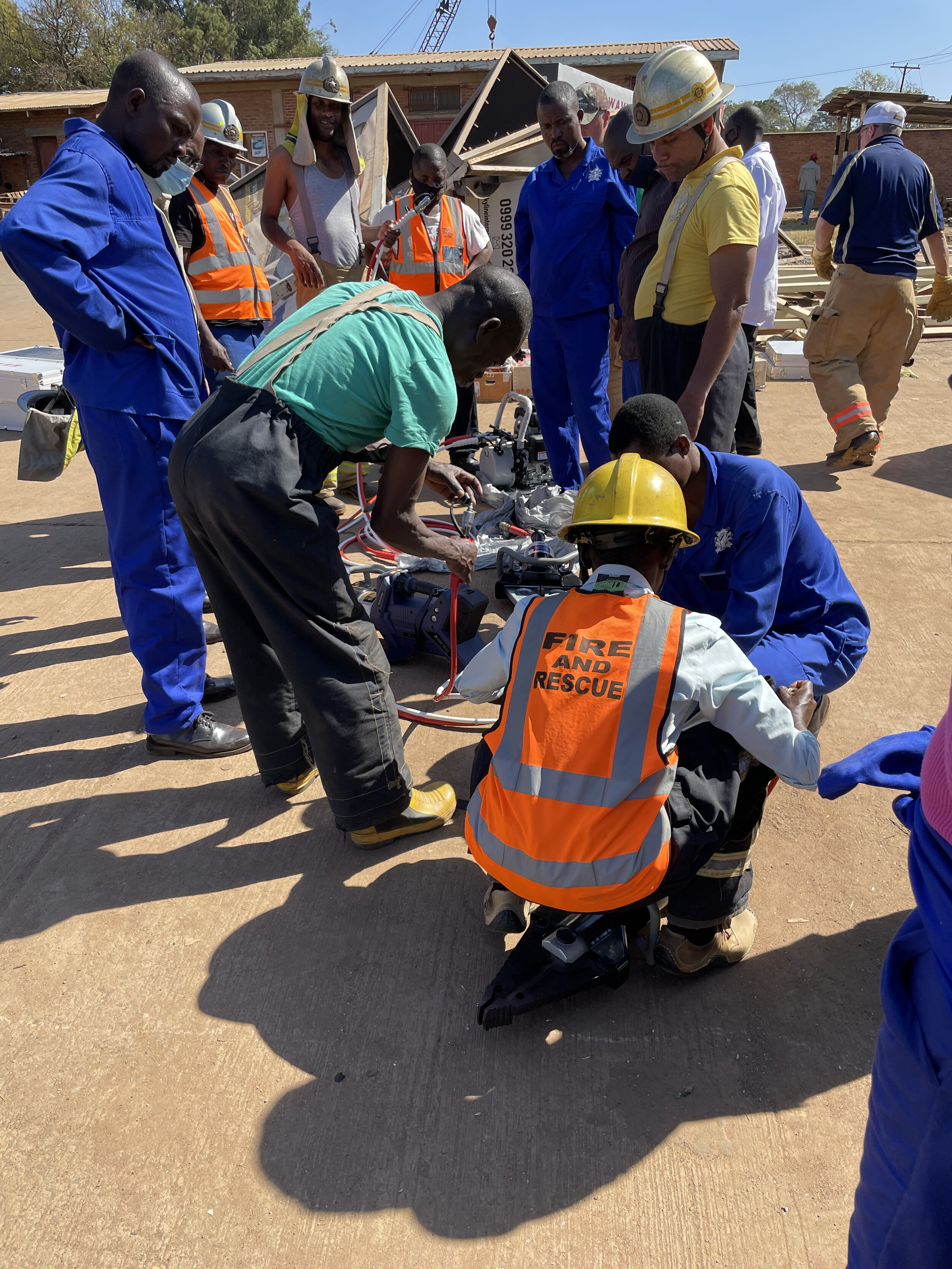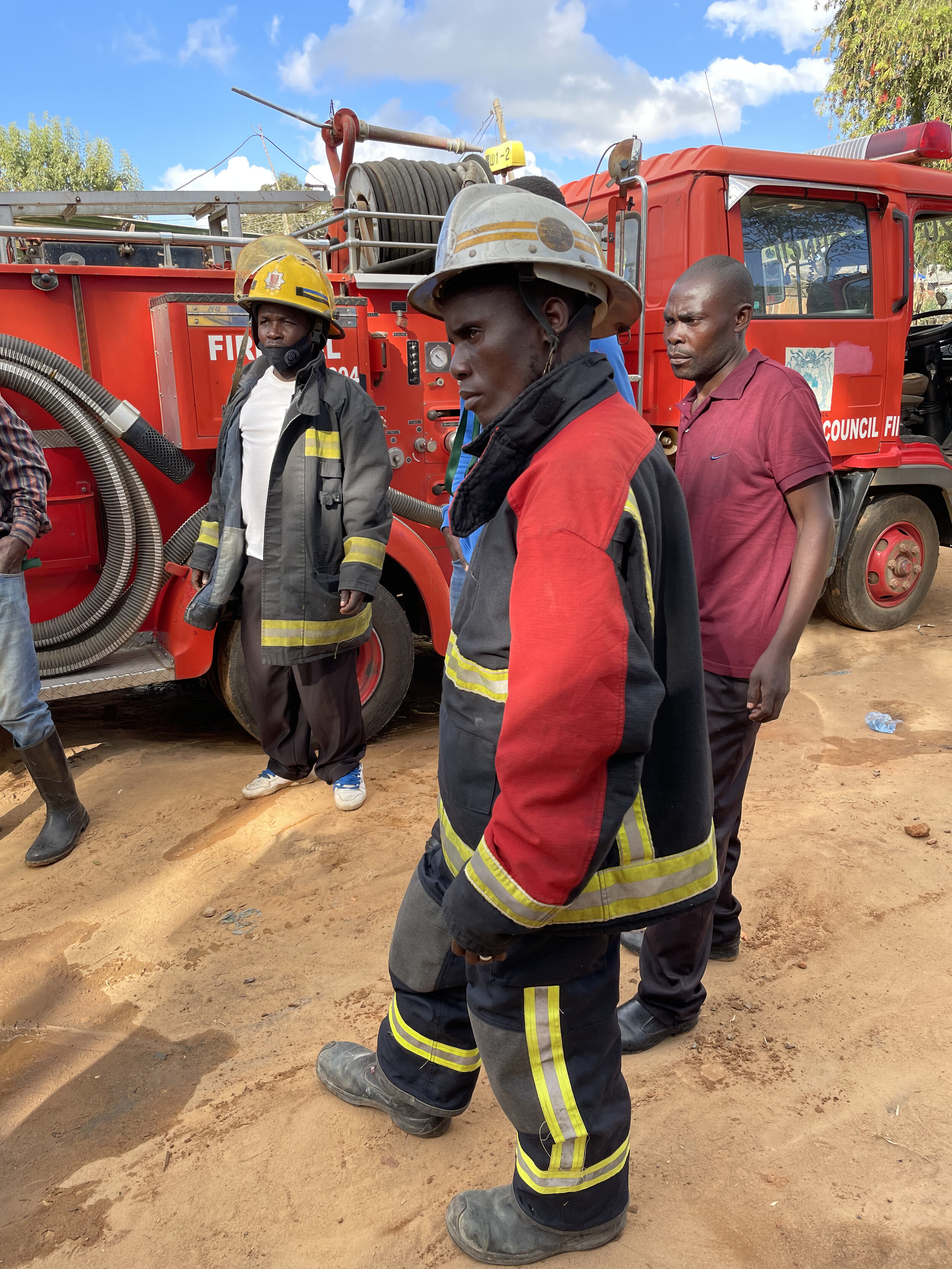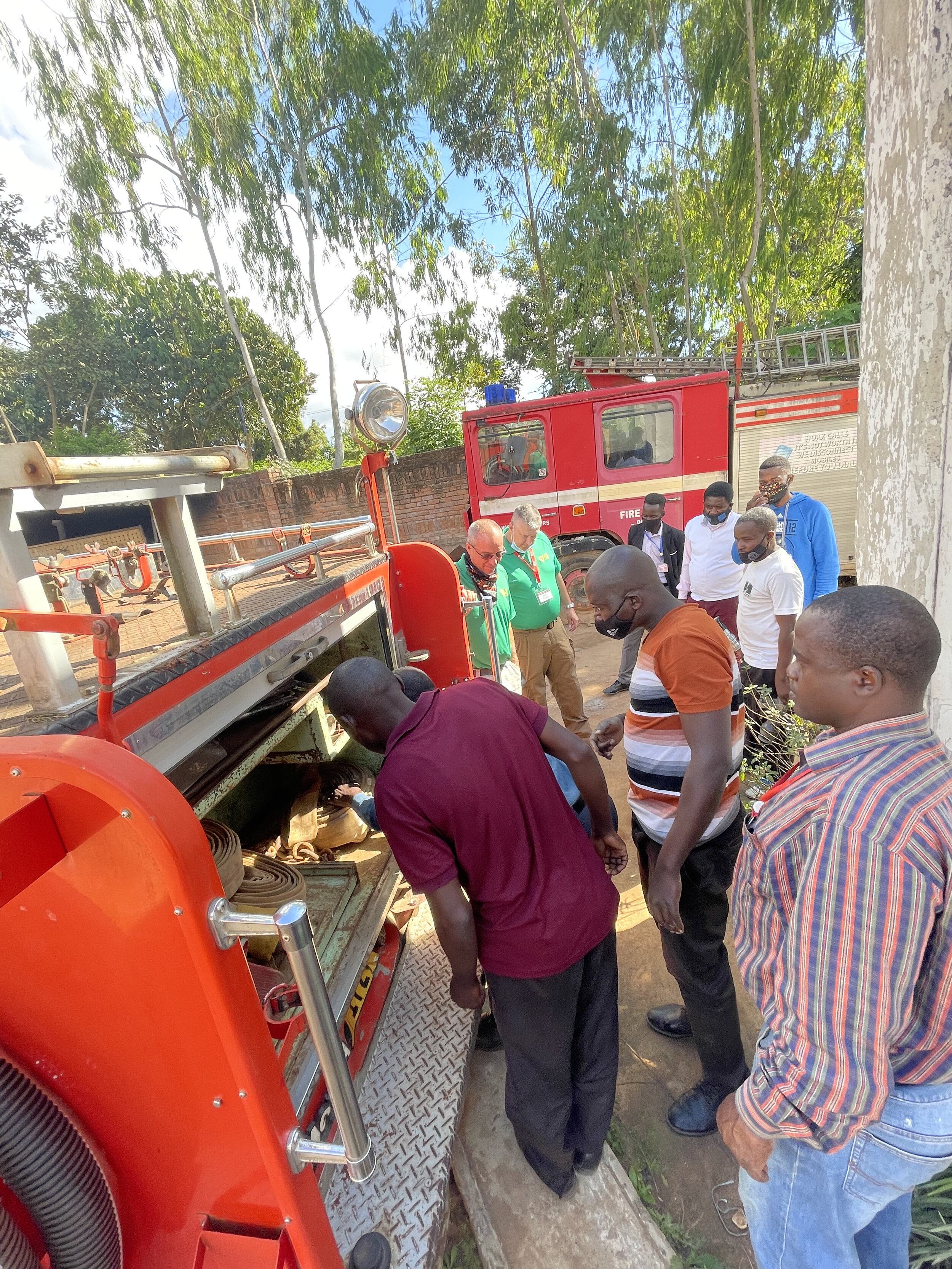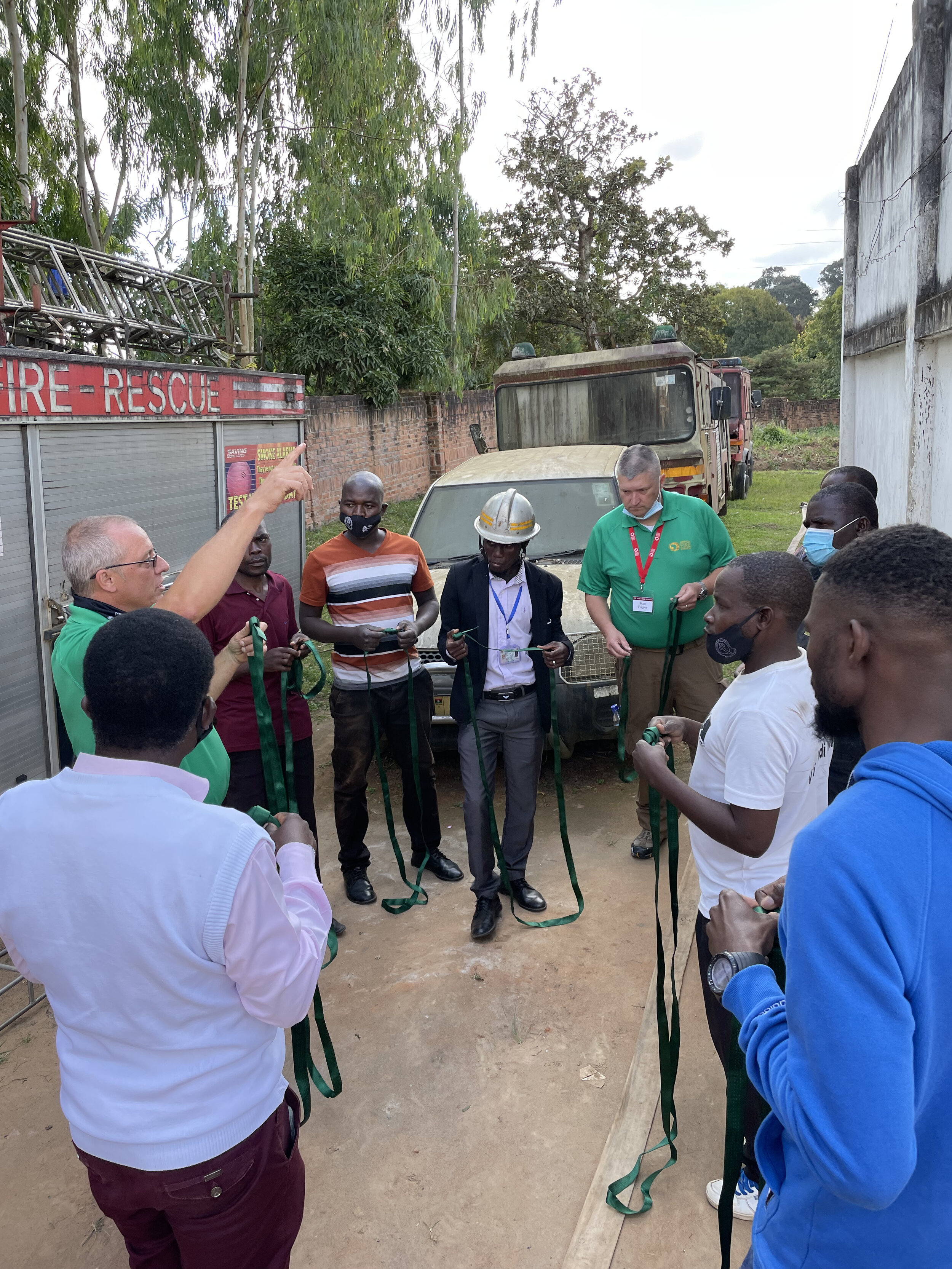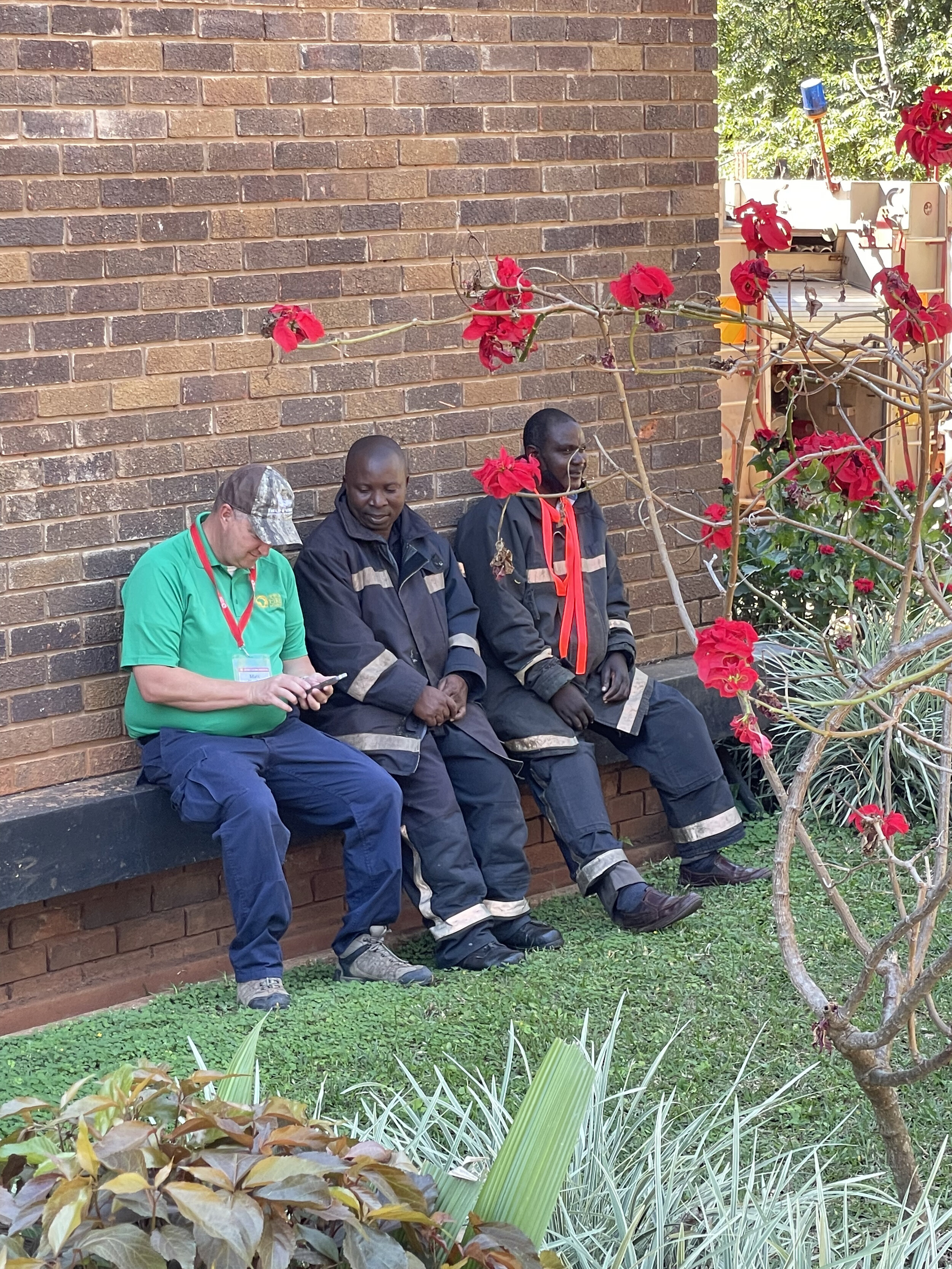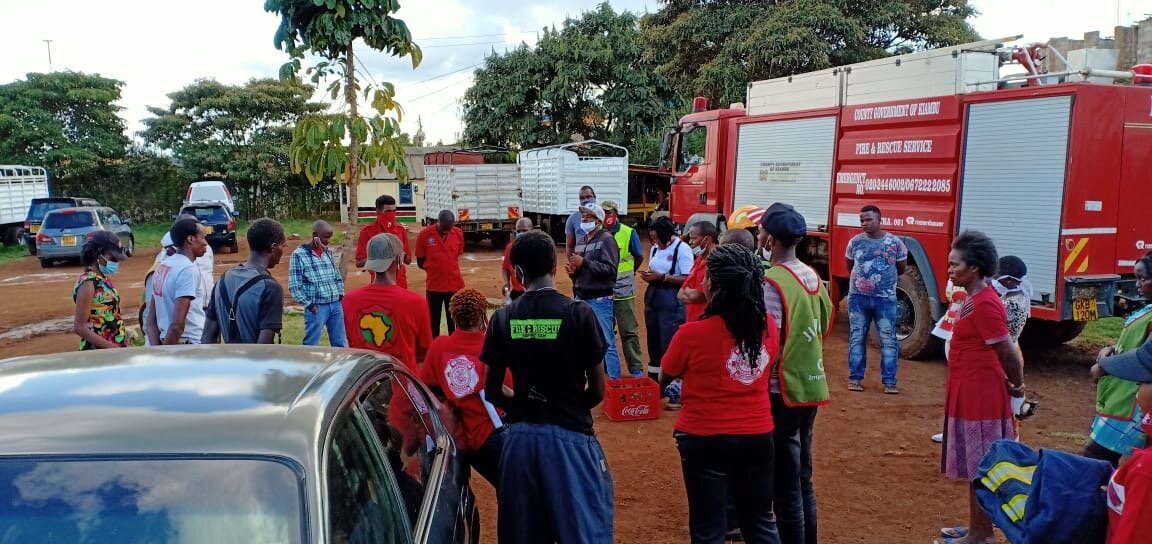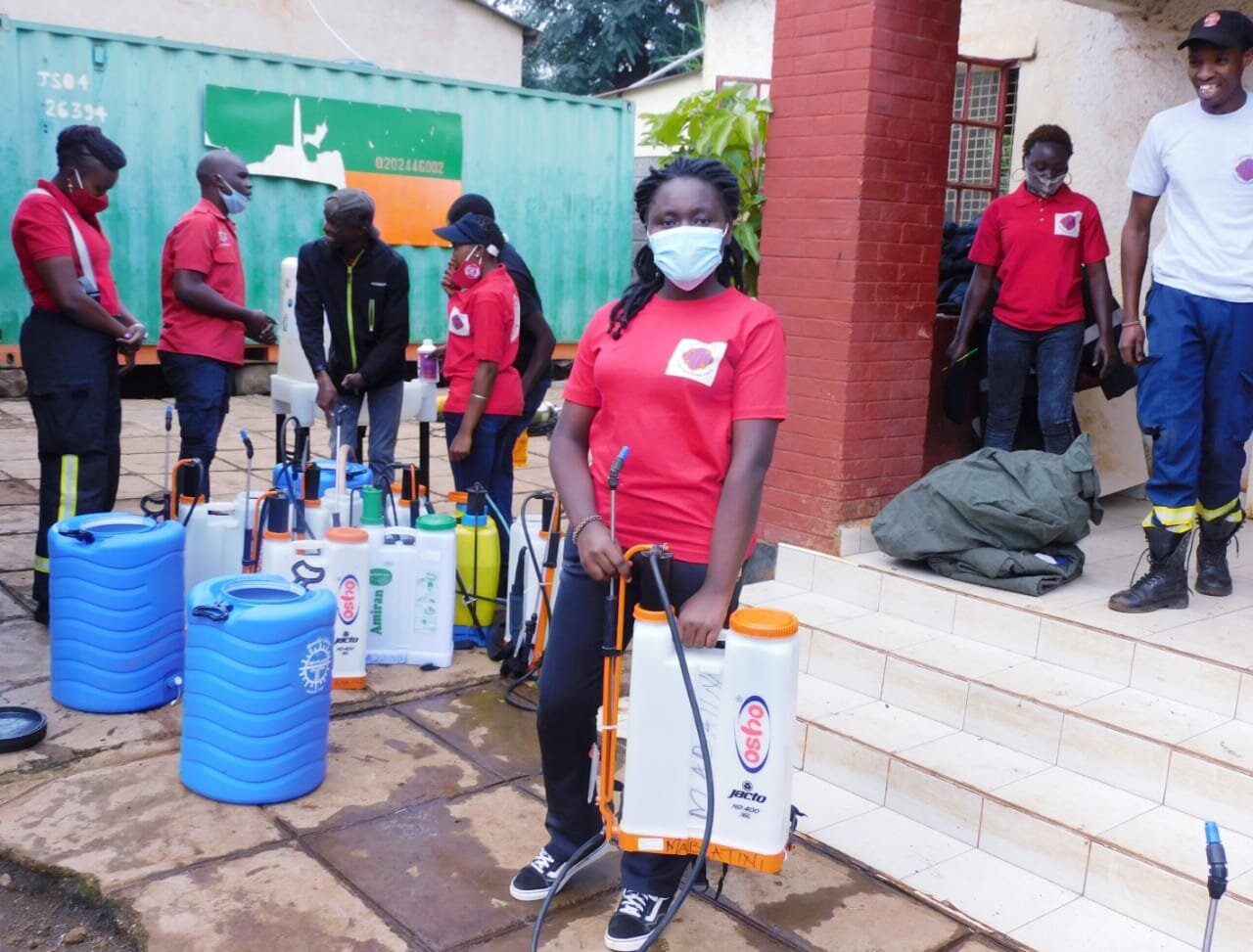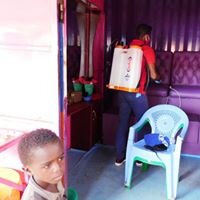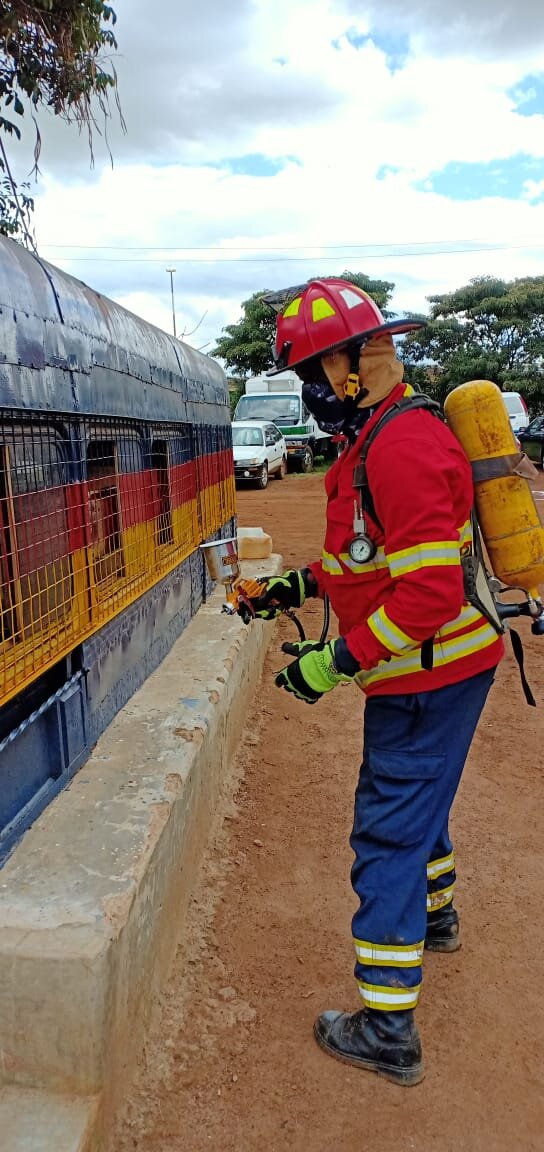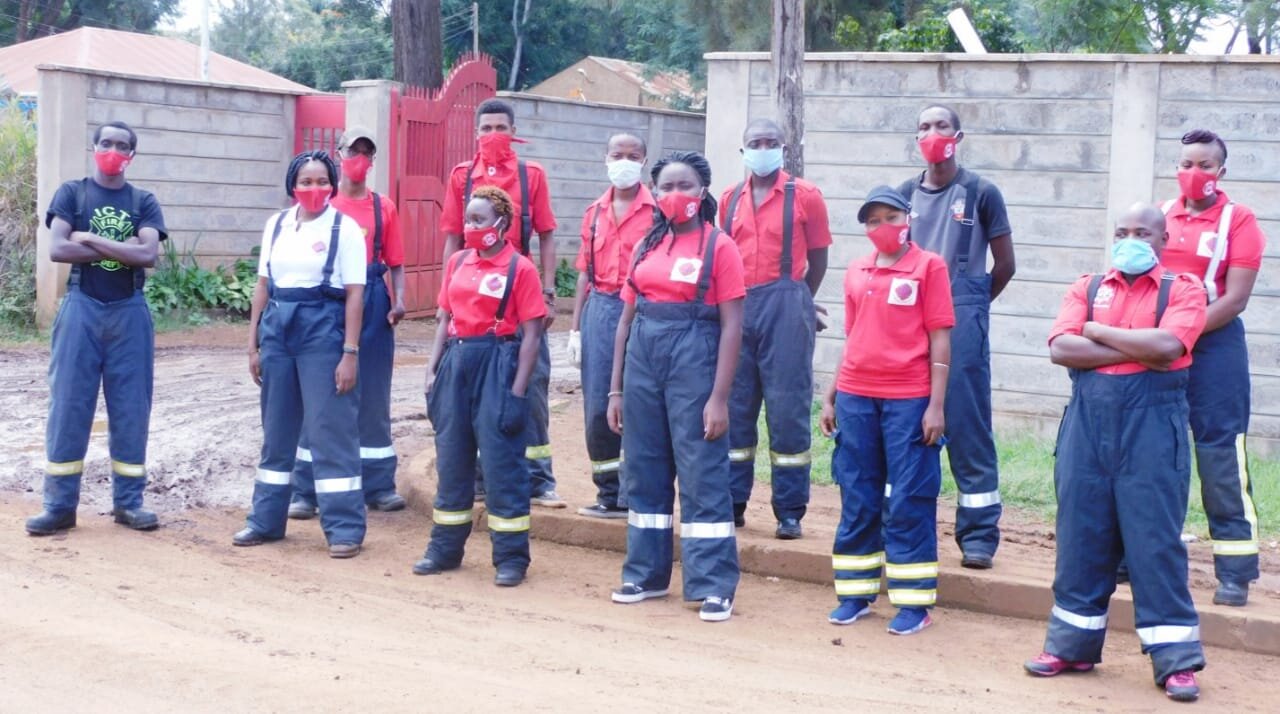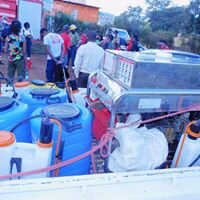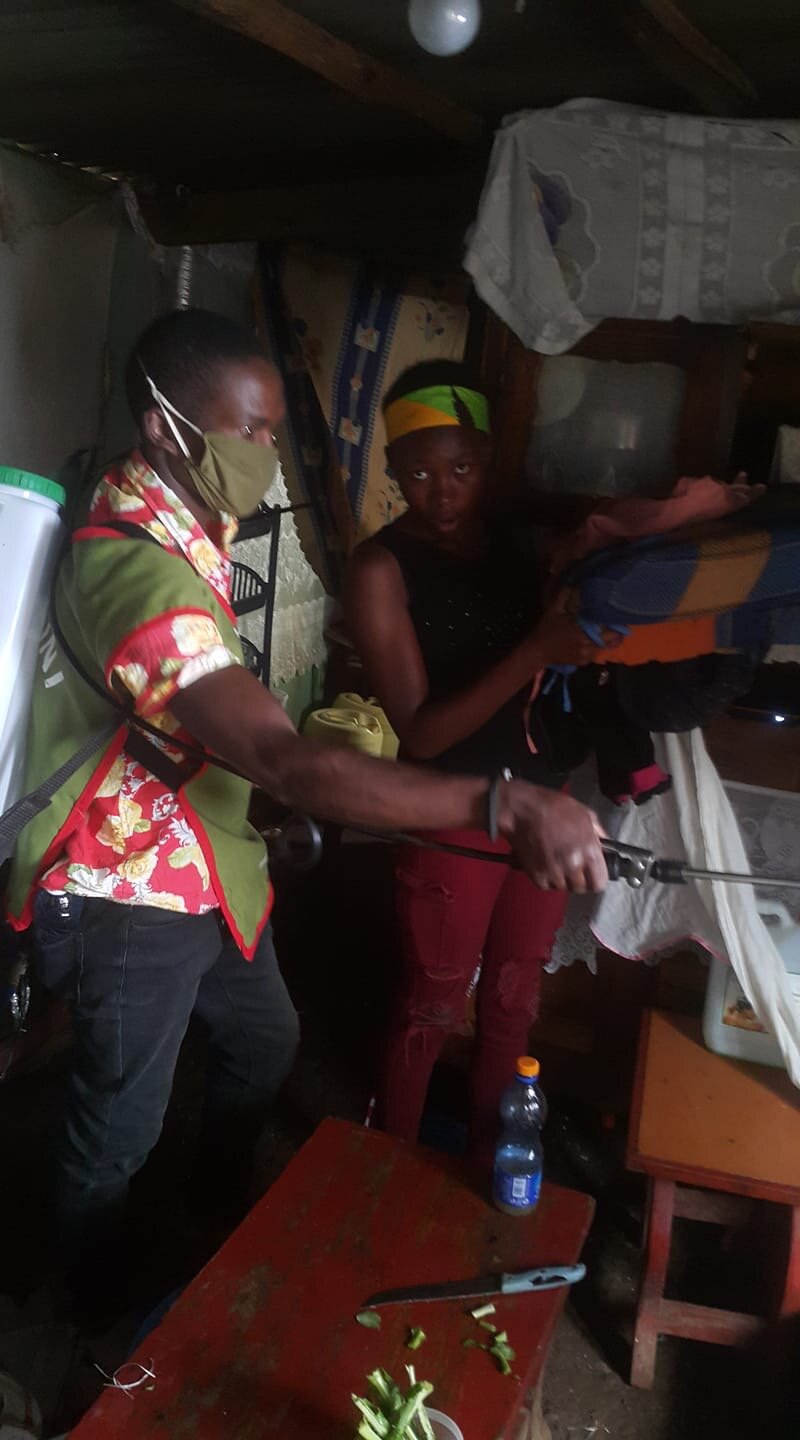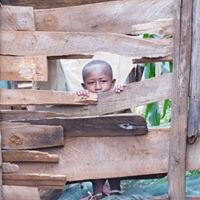In 2025, a team of firefighters from the US and Kenya traveled to Malawi for firefighter instruction and fire safety training. During this trip, three AFM team members had the unique opportunity to present fire evacuation trainings to a group of deaf and blind students in Mzuzu, Malawi. This school has not participated in any modern fire evacuation trainings or drills until this year when the AFM team visited. These drills sparked curiosity and excitement about fire safety in the students and their teachers which quickly spread to the wider community.
Recognizing the 2024 Kenya Fire and EMS Symposium Award Winners
In November, Africa Fire Mission worked with partners and collaborators around the world to hold the 2024 Kenya EMS and Fire Symposium and Competition. This Symposium featured firefighter and EMS trainings, leadership development, mental health awareness, community fire prevention trainings, and the signature EMS and Fire Competition. All of the classes were desinged to have immediate application for firefighters and EMS personel. AFM was espeically focused on leadership development in emergency services and the mental, physical, and spiritual wellness of first responders. AFM would like to recognize members of the fire service who are making a difference across Africa, as well as the award winners of the Fire and EMS Competition!
Growing Community Fire Prevention Programs
Growing Community Fire Prevention Programs - AFM’s first annual Fire Prevention Competition!
January 1, 2023
by: Nancy L. Moore, Executive Director
When my husband, Dave, and I arrived in Nairobi, Kenya in 2012 we immediately began to see the dangers of fires that are a reality of life in Africa. When we learned in 2014 that many firefighters in Zambia didn’t know the basics of fire prevention and fire safety we knew we had to do something.
From our partners at Missions of Hope International and CMF International we learned about Community Health Evangelism or Community Health Education and realized that there was very little education for developing communities on fire prevention and fire safety. So we worked together with firefighters in Africa, community members in Kenya and AFM’s American firefighter volunteers to develop a curriculum that would be culturally appropriate for developing communities.
We have trained thousands of firefighters and community volunteers in using our curriculum and have been able to track results as fire services in Africa report that communities that have received training call the fire brigade sooner in cases of fire outbreaks and that they have a better understanding of how the fire service works and what firefighters need from the community in order to do their job. In 2022, firefighters and community volunteers reported more than 520,000 people were educated in fire prevention and fire safety through training activities, community walks and fire prevention week activities. Through public television and radio more than 13 million people were received life saving fire safety education.
With more than 1 billion people in Sub-Saharan Africa - there are many more people to reach with these important life safety lessons.
In 2023 AFM has launched an initiative to reach more people by encouraging training and reporting that training through our first annual Fire Prevention Competition. We will have 4 categories for participation:
Individual Volunteer - someone who is not paid for trainings that they are providing.
Individual Paid - someone doing this as a part of their job, in the fire service, private or public sector.
Fire Brigade (paid firefighters this could be a recognition for the whole fire department what they submit across all shifts, etc).
Groups- organization or informal group (this could be firefighters or community members that are not getting paid to do the trainings and are doing it on their own time)
Trainings reported and taking place from November 20, 2022- November 1, 2023 will be considered. For the competition, trainings must take place in Africa. Participants in the competition may use the Africa Fire Mission curriculum as a guide for what training content to include: https://www.africafiremission.org/fire-safety-curriculum
The requirements to be considered include:
Submit training documentation to Africa Fire Mission via this form: https://www.africafiremission.org/fire-safety-training-reporting
Submit pictures of the training to info@africafiremission.org
Submission reviews to determine winners of the competition:
Africa Fire Mission will review the all of the submitted training reports for quality of training as well as number of persons trained.
Training photos will also be reviewed and AFM should be able to tell what content is being taught through the photos evidence.
Trainings may be done formally (for instance a classroom setting or community gathering) or informally community walk, media interviews)
Winners will be announced at the closing of the Kenya Fire EMS Symposium and Competition 2023, in Nairobi, Kenya, November 2023. Winners will also receive recognition on AFM social media and AFM’s monthly newsletter. A certificate will be issued to the winners as well as a gift (yet to be determined).
Please note: Individuals training together are considered a group, please have one person from the group submit the reports and list the name of the group with the training report. Duplicate trainings will be combined as one training report. If there are participants from multiple countries, awards may be issued by country. AFM staff will not be considered as part of the competition. AFM holds the full decision making over the winners of the competition.
Fire Prevention Activities Grow in Kenya
When Dave and Nancy , Co-Founders of Africa Fire Mission, went to Kenya in November 2012. One of the things that surprised them was the lack of knowledge around fire prevention and fire safety. In the US, children start to learn about fire safety in Pre-School and fire prevention messages and what to do in case of fire are integrated into school and work for many Americans. In most of Africa we have learned that there is very little education around fire prevention or fire safety.
As soon as Dave saw the gap he invited the Nairobi Fire Service to come to Missions of Hope International (AFM’s first partner) to teach the teachers a little about fire prevention. Stop, Drop and Roll, Crawling Under Smoke (Get Low and Get Out), how to call the fire department and how to use a fire extinguisher were among the first lessons taught. That first fire prevention session in Nairobi had about 30 participants - since then AFM has been growing our fire prevention program through curriculum and a train the trainer model through CHE (Community Health Education).
This October, Kenya participated in Fire Prevention week - at least 10 counties participated and more than 40,000 individuals received direct training in fire prevention! Children and adults conducted fire drills in their schools and businesses. Firefighters went into their communities and shared safety messages in churches, schools, businesses and anywhere that people gathered!
Indirectly, the impact was pretty great too! There were walks to raise awareness and media campaigns to share the work! Millions were impacted indirectly through these collaborations!
At Africa Fire Mission we are committed to continue to increase the impact of fire prevention and safety to save lives! It is important to our mission just as training firefighters. Our curriculum is available for free on our website - check it out here: Fire Safety Curriculum and we’d love for those using our curriculum to report their training experiences here: Report
To all the firefighters in Kenya that are spreading the message of fire safety - Asante Sana (thank you!) We can’t want to see the multiplication continue in Kenya and across all of Africa!
AMBULANCE SERVICES AND THEIR IMPORTANCE IN SOCIETY
By Kelvin, Seru Kenya EMR
An increase in medical ailments has led to the rise in hospitals and emergency medical services. These services assist patients who require emergency medical assistance at critical moments, helping them to reach the hospital on time and thus saving their life.
Private and public ambulance transportation services are operating in large numbers today to serve patients in critical condition.
Ambulance operating centers are set up at every hospital and private EMS. These operating centers function with adequate ambulance transportation services to offer immediate medical care for patients. Private ambulance transportation services depict a consistent rise in the growth curve each year offering non-emergency services, unlike hospital ambulance transportation services which primarily function for emergency needs.
Some of the non-emergency protocols include shifting patients from one hospital to another, transporting patients for any scanning or laboratory services to the relevant facilities, and having patients with traveling disabilities ride in normal vehicles to hospitals for treatments.
Emergency ambulance services are usually equipped with adequate medical equipment and paramedical professionals. Sometimes, non-emergency ambulance transportation services are also equipped with some basic medical aids and paramedical staff to cater to the needs of immediate medical care to patients.
HERE ARE A FEW THINGS TO KNOW ABOUT PARAMEDICS, WHO ARE THE BACKBONE OF AMBULANCE TRANSPORTATION SERVICES.
1) Paramedics or paramedical professionals are the first to treat patients, even before doctors. They save patients through immediate medical procedures ensuring the vitals are stable before reaching hospitals for further treatments.
2) Paramedics are trained healthcare professionals and sometimes have equivalent training to doctors. They can be authorized to assist patients with required medications and procedures.
3) Paramedics roles were established before World War I and their services were mostly rendered to soldiers on the battlefield. In those days their function was closely associated with the military. Later, ambulance services with paramedics were put into function to offer immediate medical care for civilians as well.
4) Education level, standards, functions, and skills of paramedics vary by country. However, certain standard functionalities remain common. Such as being trained to practice CPR, procedures for cardiac arrest patients, usage of defibrillators, certain analgesic, paralytics, sedative medications for pain control, first aid to treat burns, fractures, childbirth complications, spine injury, airway management, blood control, etc.
6) Paramedics and physiotherapists have one of the noblest professions in Kenya Africa and the world at large. Earlier physiotherapy did not gain as much recognition as today where physiotherapists are looked at as saviors offering treatments as an alternate to surgical procedures in most of the cases and post-surgery maintenance for a quick recovery to a normal lifestyle.
7) One should respect the noble service of pre-hospital providers who form an integral part of ambulance services.
8) The youth of our nation should get involved in such noble services by joining community life-saving teams and getting careers rather than wasting their resource and potential indulging in unwise activities.
9) Moreover, the government should take initiatives to support the volunteer first responders at the community level and to empower them to continue saving lives at the scene, before qualified personnel arrives.
WHY SHOULD BOTH A FIRE TRUCK AND AN AMBULANCE ALWAYS SHOW UP FOR A MEDICAL EMERGENCY?
When a call comes in, dispatchers often are not given precise or complete information.
As such, units are dispatched ready for the worst-case scenario. To ensure the highest level of care, the closest fire engine station is dispatched, and EMS sends an ambulance (staffed with two paramedics).
No medical call is “routine.” At a minimum, most emergencies require assessing the patient, obtaining their vital signs, providing oxygen therapy, and moving them.
EMS may also need to place an advanced airway, administer drugs intravenously, or monitor cardiac conditions. All of these procedures are completed more efficiently when the appropriate amount of help is on the scene.
Efficient care is our goal, and it is often the difference between life and death.
Unfortunately, units have no way of knowing what they will encounter on a call until they arrive. They work in a “what if” and “all-risk” business.
Responding to the unknown is public safety.
Emergency hotlines are your instant go-to when the need arises. That’s why it is important that you keep a copy of each of the important ones with you.
There are 4 fire stations in Malawi!
by Nancy Moore
We’d last been to Malawi in 2017 when Co-Founders Dave and Nancy Moore went on a vision trip. During that trip they worked to better understand the needs of the fire service and their dreams of the future as a better fire service. Lodious - the Fire Chief in Zomba, Malawi has a vision for Malawi’s fire service and made sure to share it with us.
Malawi has four fire stations - you read that right - four. For perspective land mass wise, Malawi is about the geographic size of Pennsylvania and there are four fire stations and less than 100 firefighters in the country. Firefighters are misunderstood by their community and under equipped to serve the communities where they are located. Firefighters are often stoned and ridiculed by the communities they are trying to serve.
AFM began looking for the right partner that could help us reach out and train the firefighters and the community across Malawi. Our friends at Namikango Mission were part of that next step, and something was missing. During conversations with Parkview Global, Orland Park, IL and their initiative for Peace Plan Malawi it became clear that we’d be able to partner with Peace Plan Malawi and reach the fire service across Malawi.
Finally, in June 2021, we were ready to travel with a team from Parkview to serve in Malawi. God provided a way for us to go even when the borders were closed to foreigners due to contacts in Malawi’s National Government and Department of Health.
While we were in Malawi, we we able to provide firefighter personal protective equipment to the Zomba Fire Brigade.
We were able to train firefighters from 3 of the 4 fire departments in the country (Mzuzu, Lilongwe, Zomba)! It was difficult to see the lack of equipment, the lack of PPE and the broken equipment. At one fire station there appeared to be 4 fire trucks - as we asked questions we learned that only one was in working condition.
We were able to pray for the firefighters and share God’s love with them as we conducted training on hose operations, using ladders, and search and rescue operations.
In Lilongwe, we found out that there were new Jaws of Life (Vehicle Extrication tools) that had been sitting in storage for over a year because no one knew how to operate them - and we were asked if we could teach them - YES! In a few days time we trained on the new equipment and it was able to be put into operation at vehicle accident scenes to save lives!
We are looking forward to what our work will look like in Malawi in the future and are planning to take a team of firefighters to serve in Malawi in June 2022!! Learn more about our mission trips here >
Importance knowing the Fire Department Emergency Contact
By Kelvin, Seru Kenya EMR
Picture how you would react in your local area, home, learning institutions, office or work one day when a fire broke out and you hadn’t the faintest clue where to start, what to do or who to contact about the situation. Imagine running to the area local administrator, manager or director’s office to obtain a point-of-contact information about the fire department only to be told there is none available.
Or maybe you are headed home and a fire broke out. Concerned bystanders try to help and would like to contact the Fire and Rescue Services but no information is found. This is often the case for many in Kenya, Africa.
Fire emergency contact information and numbers are very important for every individual, institution and organization to know, yet it is easily overlooked and forgotten by many—both employees and managers. Fire emergency contacts are the phone number or numbers for your local Fire and Rescue Services (access emergency numbers for Kenya here) . It is also important to know what to say when you call, using 4WCT.
W- who you are
W- what you need
W- what happened or is happening
W- where the incident is
C- confirmation of the information
T- time the incident took place
It is important to ensure each employee, local community group or volunteer, organization, institution, and office has accessible, well-written fire department emergency numbers placed at every corner; and also an action plan which indicates a step-by-step procedure of what to do in case of a fire outbreak. Also, having individuals who are trained as fire marshals in your local community, company, organization or institution will help in a long way.
From experience, it is also advisable for every County’s fire service to have a toll-free Emergency number for everyone in the community to reach them.
Most of the time the fire department would respond to a fire late due to the delay in contacting the fire department. As a result, the fire engine ends up being stoned by the local community and even at times even stealing items from the fire engine. Community members tend not to understand our response time starts from the time we receive the call but not when the fire starts. It is critical that we educate community members on the local contact numbers (see Kenya fire brigade numbers here)
For every individual, community volunteer, organization head, and institutional management: please make this a part of your monthly announcements to your employees and the general public the importance of having with them their respective area’s fire department emergency numbers, which will make it easier for everyone to reach First Responders.
As a Chinese proverb says, “Better a thousand times careful, than once dead”, so please do what you need to do to be safe, rather than sorry.
#TogetherForSafety
Firefighter community outreach - International Firefighters Day 2020
Firefighters in many parts of Africa are disrespected by their communities. Community members don’t understand them and will often throw stones at the firefighters when they arrive on fire and rescue scenes. Firefighters are frequently injured and equipment severely damaged. Yet firefighters continue to respond to serve their communities. In Kenya, firefighters have been working hard to educate their communities about how to prevent fires and how to respond to fires (things like knowing to call the fire brigade and knowing the number to call).
In the midst of the global COVID-19 pandemic a group of career and volunteer firefighters decided to celebrate International Firefighters Day (May 4th) by reaching out to a slum community - their goal was to build relationships between the firefighters and the community.
On May 9, 2020, a group of 18 firefighters and 12 community volunteers (from Jiamini Self Help group) collaborated with the Kiambu Fire Brigade in Thika to fumigate the Kiandutu slums with COVID eradication solution and spray bedbug eradication solution in homes. The firefighters and volunteers reached 15,000 people and were able to share life saving fire safety information!
This event was fully supported by the firefighters - the firefighters contributed their own time, talents and finances to the event. As others saw their commitment, the Kiambu County Government and other people and organizations got involved too. Firefighters across Kenya those employed and volunteering, contributed money to purchase bedbug killer. The Kiambu Public Health department provided COVID-19 fumigation solution that cleans the streets and the Kiambu Public Works who offered mist generator, fire truck and a utility pickup to transport the tools of trade to the activity area. Missions of Hope International provided supplies for the event as well.
This activity may be the first of many in this area as the community is excited to learn more about the fire service after these acts of kindness. It is a great example of community driven development and how AFM’s CHE model can be put into action by the fire service. Much can be done with little to improve the fire service in Africa and the communities around them. What can you do to improve your own community?

